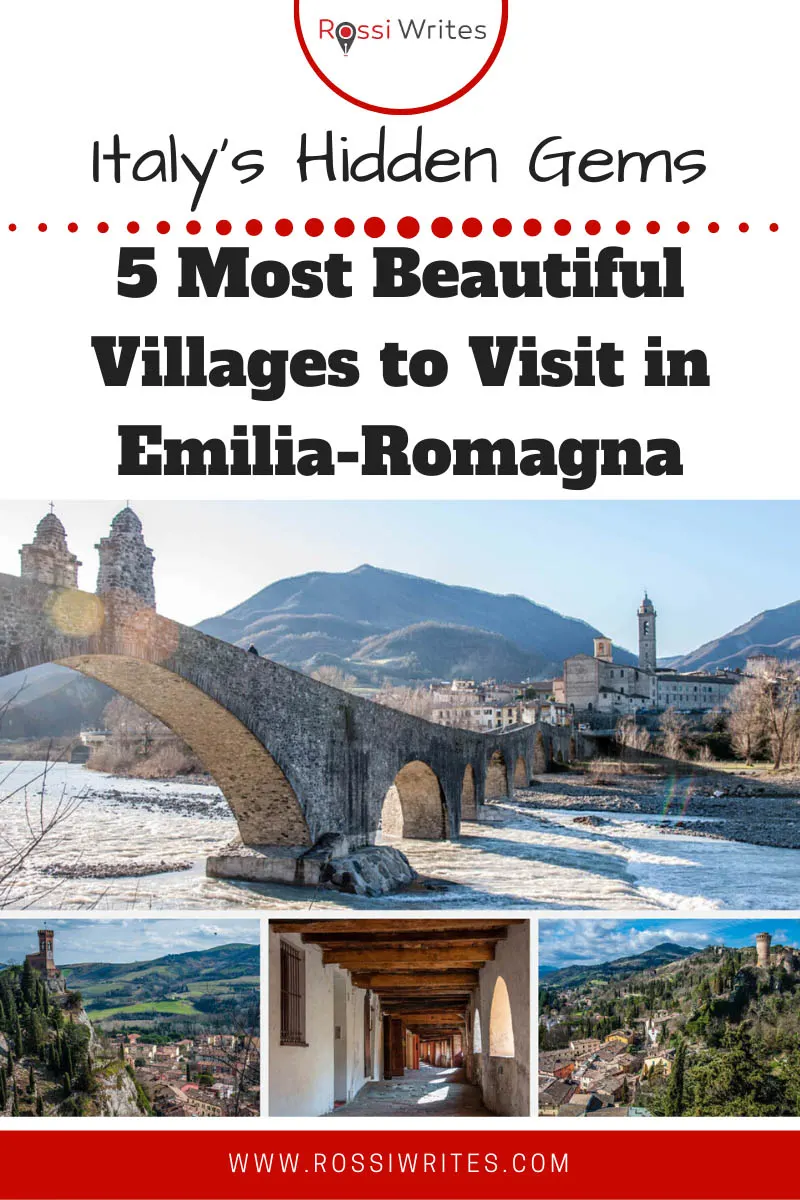Emilia-Romagna is the Northern Italian region that is top of the travel wish list of every foodie, sun worshipper, and history lover.
From its centuries-old culinary traditions (hello, balsamic vinegar, Parma ham, and parmesan!) to its sprawling beaches, Emilia-Romagna has a lot to offer no matter what your travel intentions are. With deep historic roots that stretch back to Etruscan and Roman times and with famous sea resorts among its most popular destinations, the region is a pleasure to explore.
You can spend days in Emilia-Romagna’s capital Bologna delighting in the local food and unmissable historic sights (pride of place among them takes the world’s oldest University which was founded in 1088).
You can then dedicate some time to one or more of the region’s other important cities like Modena, Parma, Piacenza, Ravenna, and Rimini to mention but a few. From food museums and Byzantine mosaics to medieval castles and Baroque art, each of them will offer you endless opportunities to make travel memories to last you a lifetime.
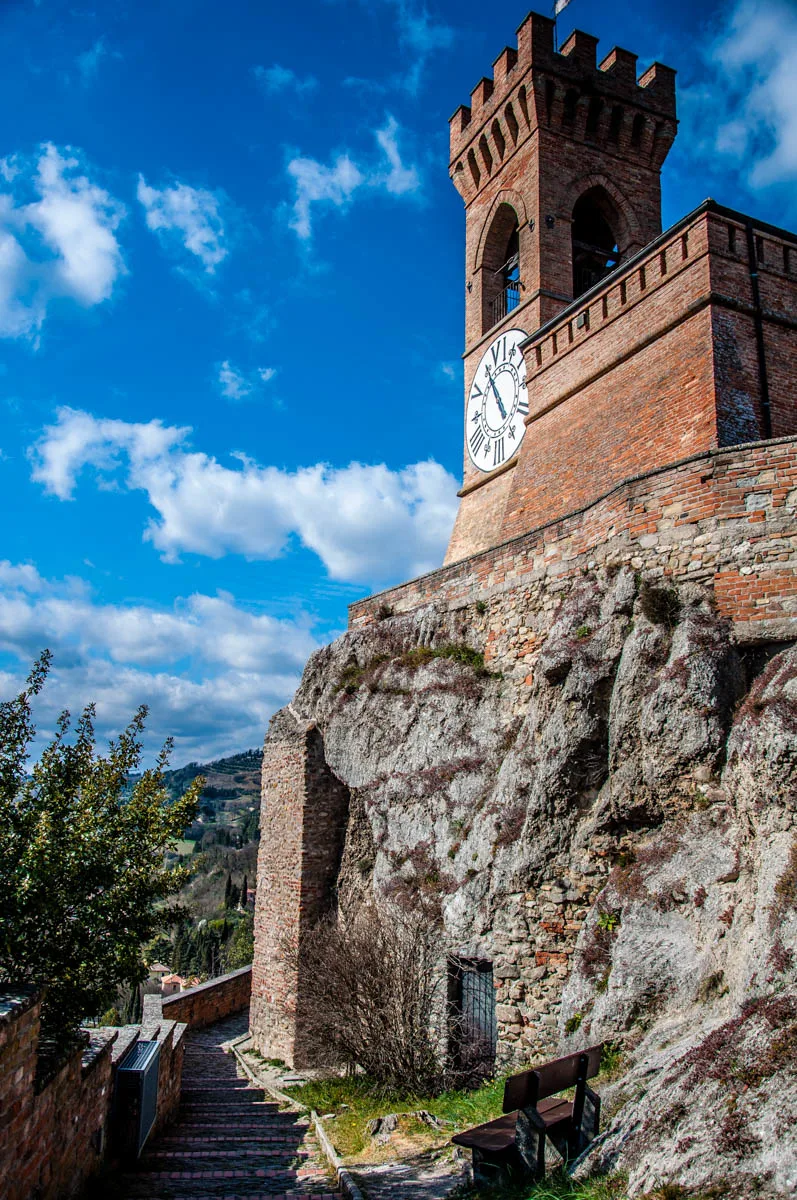
Yet, if you limit your time in Emilia-Romagna just to its main cities and its sea resorts, you will miss the chance to get to know this corner of Italy in the most authentic and intimate way. The key to the region’s heart is held by its small and beautiful villages that are dotted among lush hills and on the banks of fast rivers.
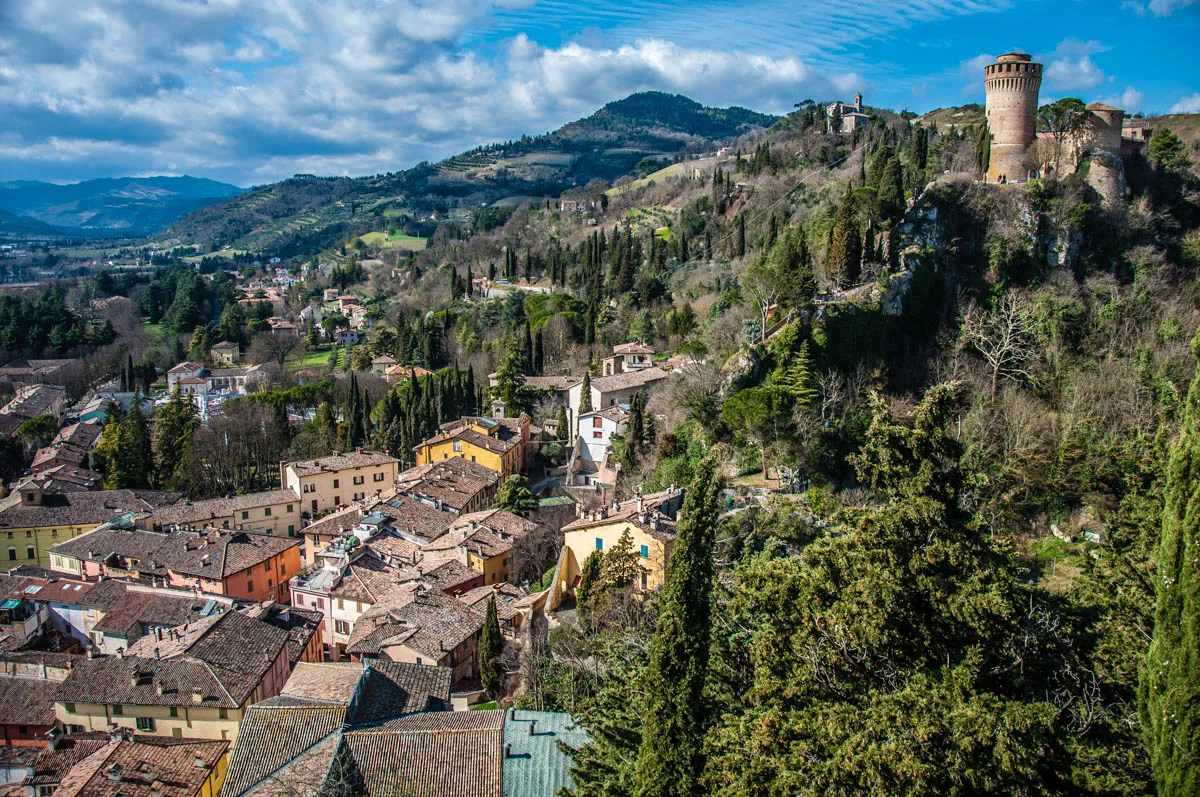
Overlooked by hilltop castles, with churches that preserve priceless frescoes and mosaics, and with curious local stories to tell, visiting Emilia-Romagna’s villages means getting off the beaten track to discover stunning landscapes and customs that go back hundreds of years in time.
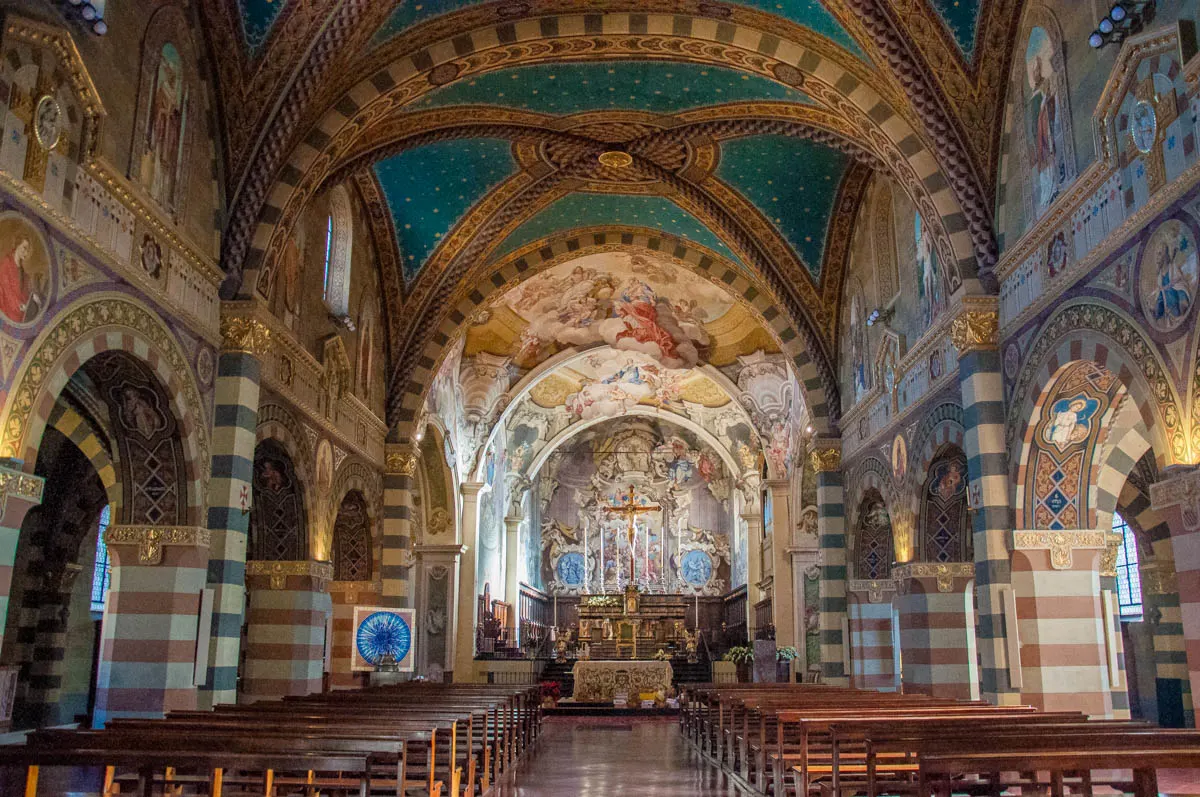
So, today, I’d like to introduce you to five of Emilia-Romagna’s most beautiful villages that I have had the chance to explore first hand. They are called Bagnacavallo, Bobbio, Brisighella, Castell’Arquato, and Grazzano Visconti.
Each of them has a unique story to tell, curious local sights for you to discover, and quiet beauty to make you stop in your tracks and spend lovely moments just taking it all in.
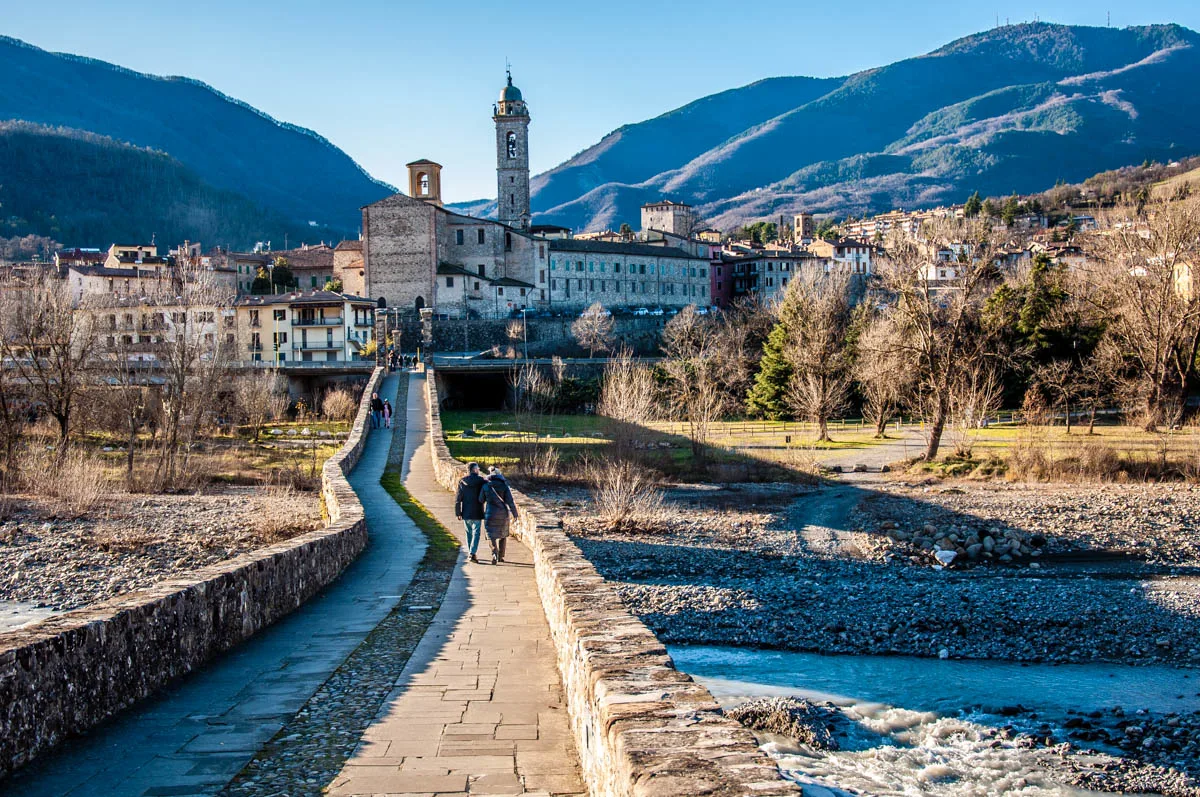
In addition, Bobbio was officially elected as Italy’s most beautiful village in 2019! Plus, it is also thought that its one-of-a-kind Devil’s Bridge was the inspiration for the bridge painted by Leonardo da Vinci behind the left shoulder of Mona Lisa.
How totally cool is that?!
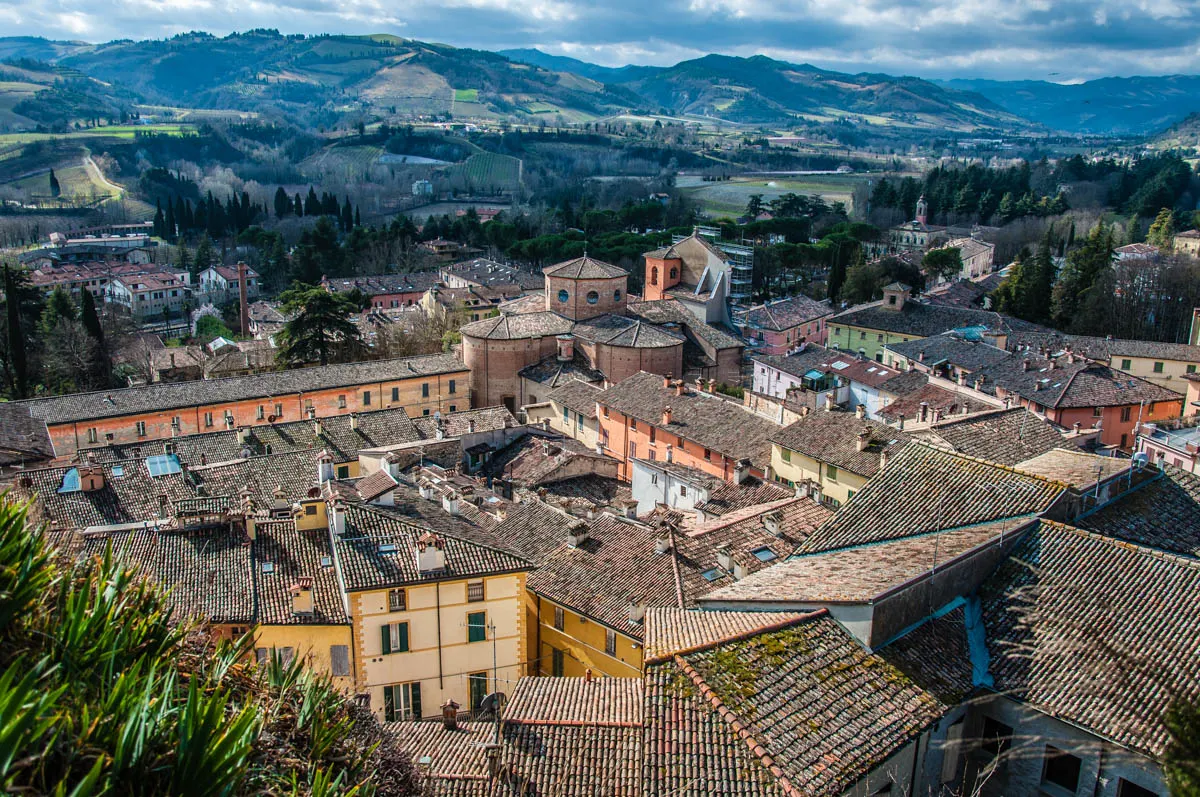
Brisighella and Castell’Arquato also feature on the official list of Italy’s most beautiful villages.
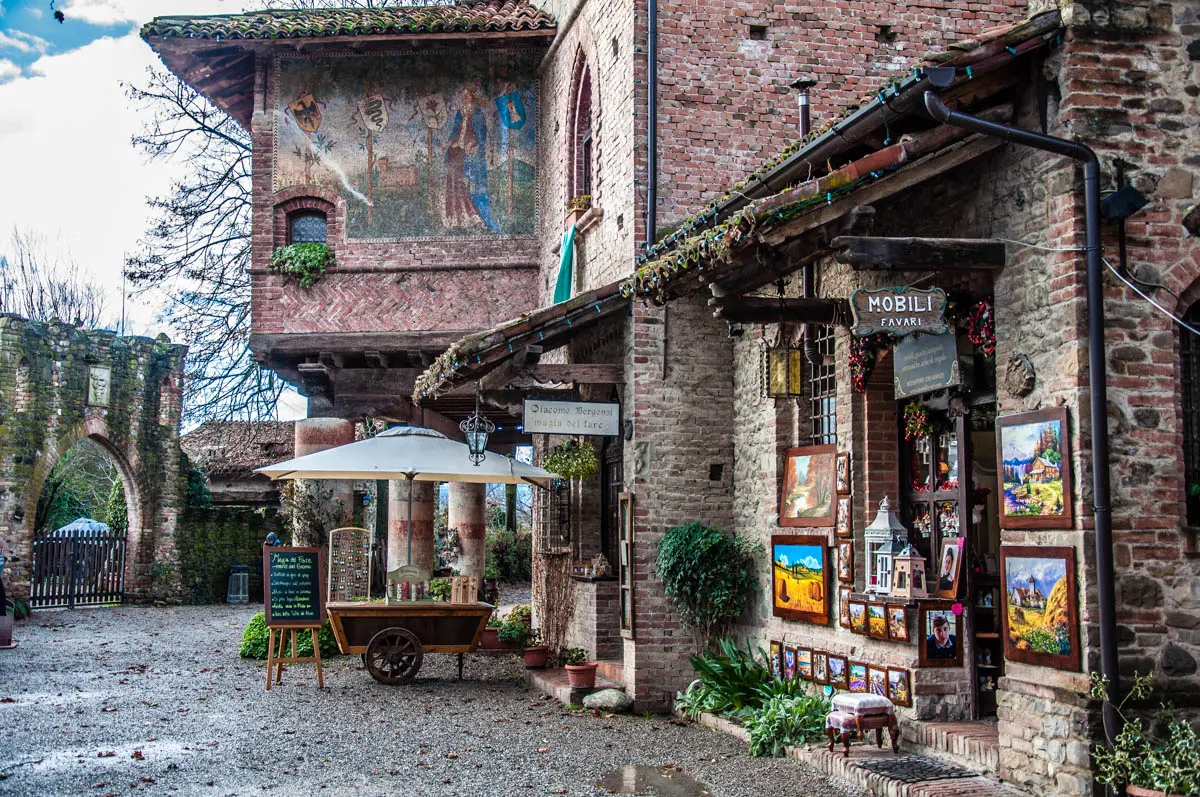
Officially recognised as beautiful or not, I loved visiting all five villages in Emilia-Romagna on my list below.
Discovering their sights, walking on their cobbled streets, visiting their ancient churches, and scaling the hills on and around which they are built were all incredible experiences that I want to share with you today in order to give you the impetus to explore Italy off the beaten track and discover its beauty in the most authentic way.
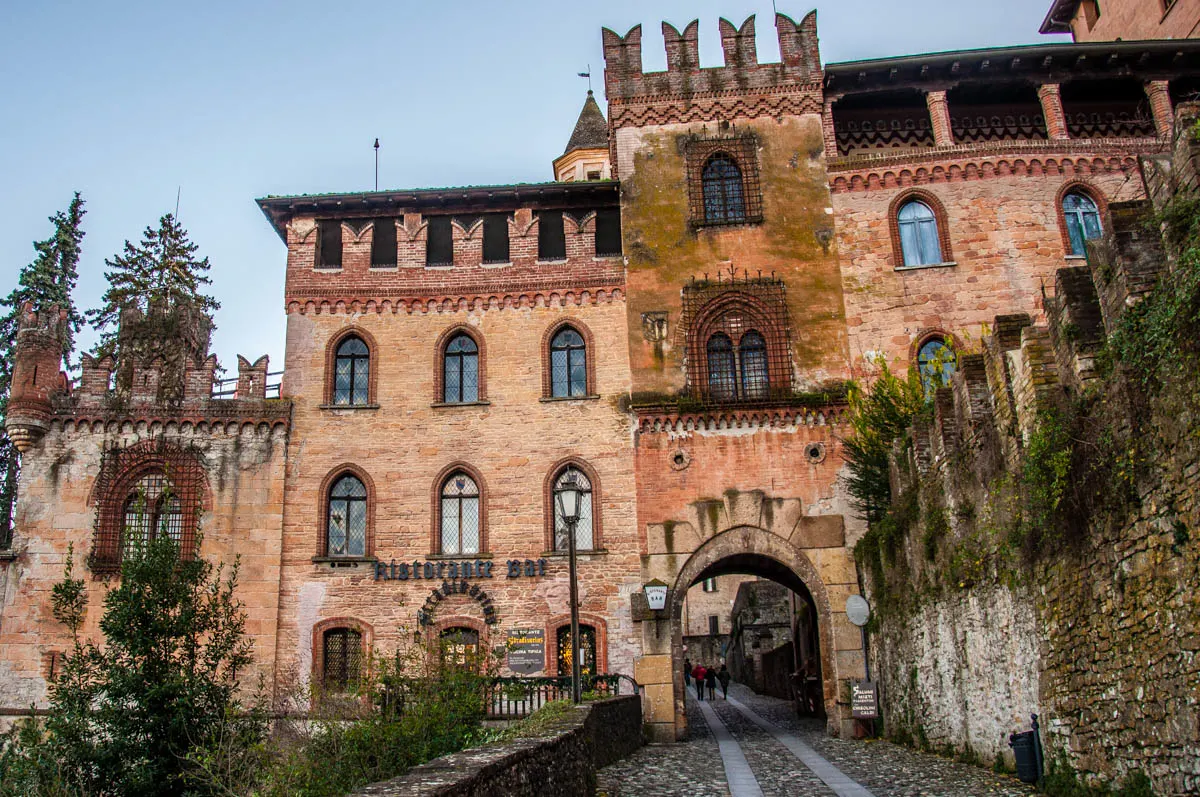
You can combine a visit to one or more of the five villages in Emilia-Romagna recommended herewith with a trip to one of the region’s main cities. All approximate times of travel given below are by car and based on Google Maps.
Between millennial history, local traditions, and excellent food you will get the full picture of what makes Emilia-Romagna one of the best destinations in Italy for you to explore and delight in.
Now, without further ado, let’s start! In strictly alphabetical order, here they are:
5 Most Beautiful Villages to Visit in Emilia-Romagna, Italy
Bagnacavallo, Province of Ravenna
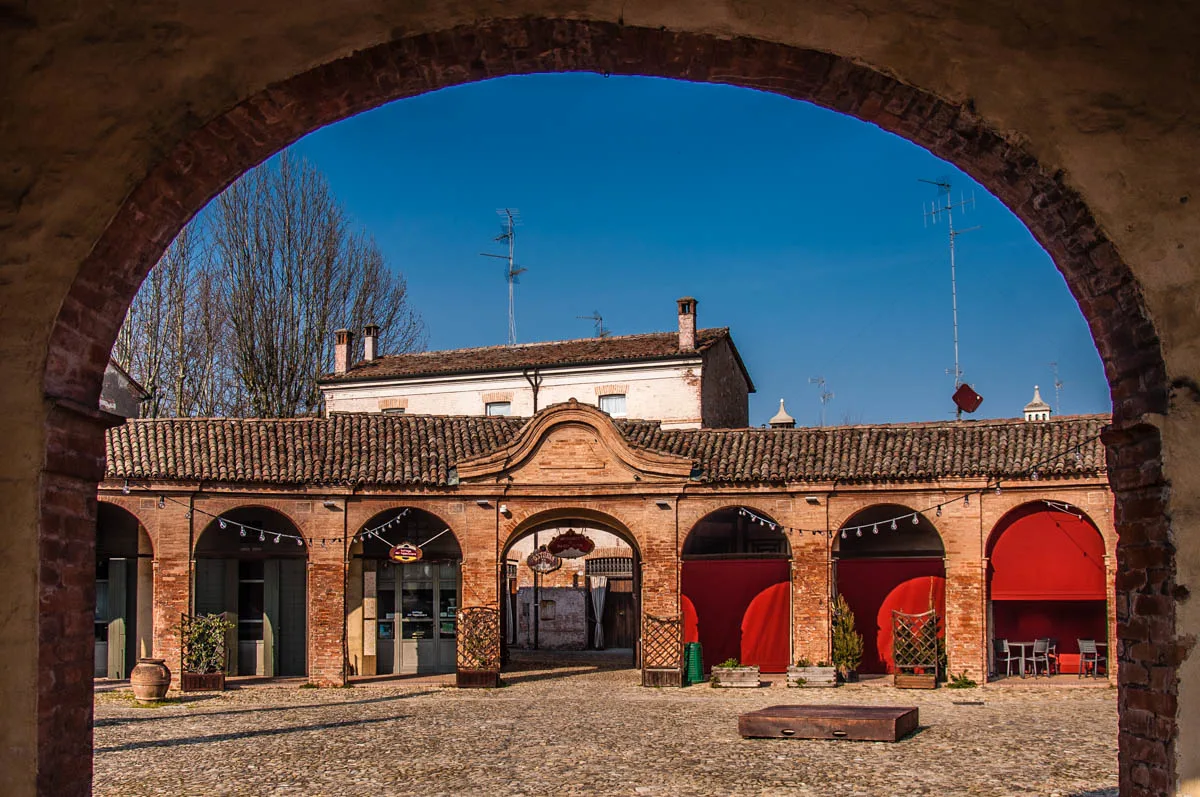
Once an important centre in the plains surrounding the city of Ravenna, nowadays Bagnacavallo is a sleepy village in Emilia-Romagna which took hold of my heart and imagination with its houses in faded terracotta shades and perfectly elliptical Piazza Nuova.
Erected in the midst of what once were marshy lands, Bagnacavallo roughly translated in English means ‘horse bath’. The village takes its name from a dangerous river crossing – a ford where the horses had to step deep into the water in order to reach the other bank. A local legend though claims that Bagnacavallo owes its name to a curative thermal spring that restored to health the horse of the Roman emperor Tiberius.
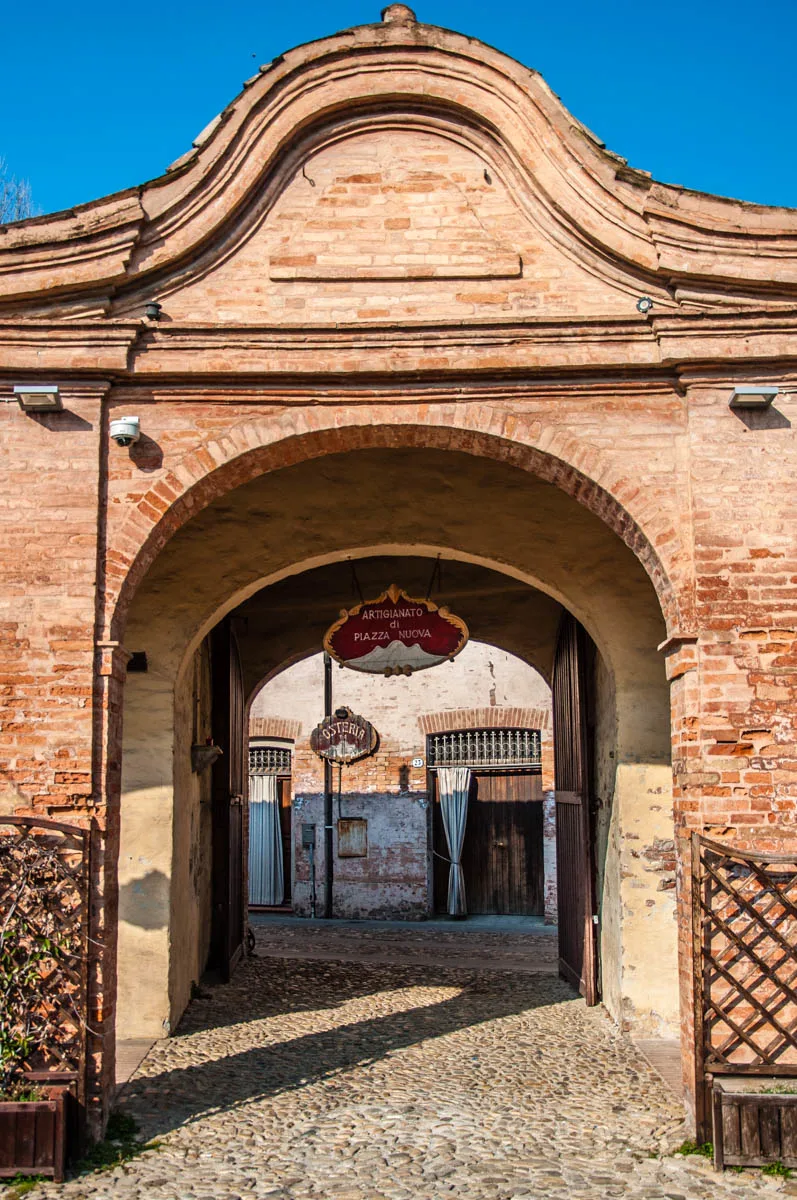
With ancient roots that stretch back to the Bronze Age, the area where Bagnacavallo nowadays stands has been attracting people for millennia. From Etruscans, Gauls, and Romans to Italian medieval dynasties, the list of people that lived and conquered these lands makes for a long reading.
Bagnacavallo reached its Golden Age in the 15th and the 16th centuries under the rule of the House of Este from which several of Europe’s royal dynasties later sprung. An earthquake in 1688 however destroyed most of the village’s architecture from that period. Thankfully, many works of art were preserved.
Nowadays, you can admire them in the Museo Civico delle Cappuccine. It also houses works by the Renaissance painter Bartolomeo Ramenghi who was born in the village and as such was known under the moniker of Il Bagnocavallo. Ramenghi was a pupil of Raphael and worked alongside him at the Vatican.
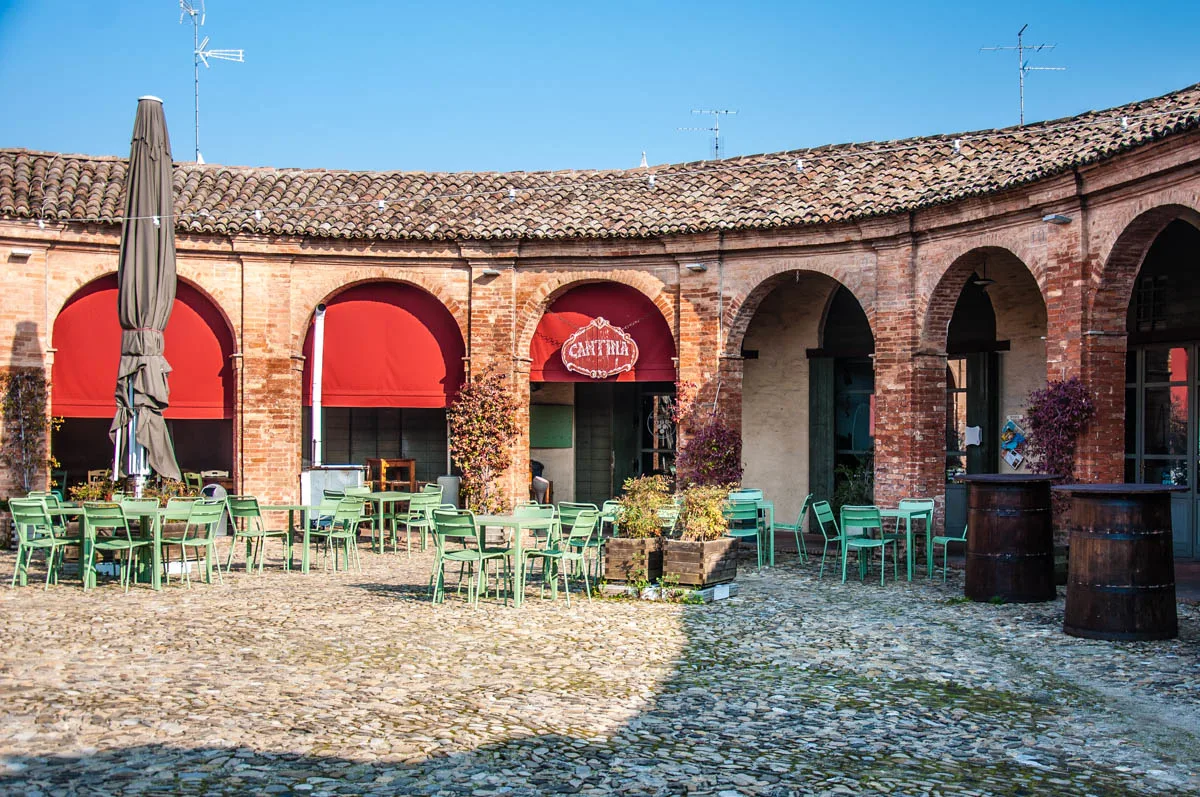
Another famous citizen of Bagnacavallo was the Passator Cortese (also known as Il Passatore). A 19th-century bandit at the head of a group of lawless men, he was idealised by the locals to the point of becoming a Robin Hood figure in those lands.
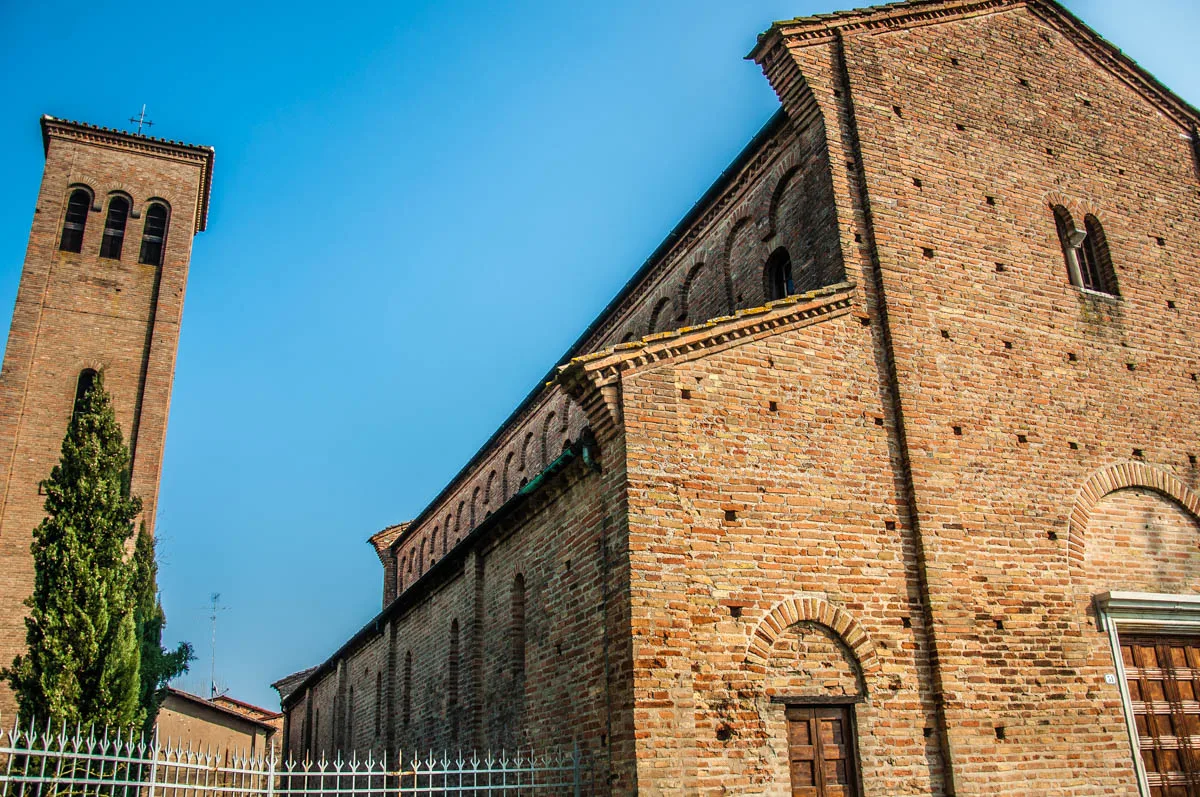
Special interest in Bagnacavallo deserves the 7th-century Church of San Pietro in Sylvis that was built near a former sanctuary of the Roman god Jupiter.
With sylvis meaning wood or forest, in ancient times, the church was next to a densely forested area while nowadays it’s simply on the outskirts of the village. It has a humble facade but inside it has a large cycle of frescoes from the early 14th and the 15th centuries.
Bear in mind that the church has reduced opening hours, so, please, click on the above link for up to date details to help you schedule your visit accordingly.
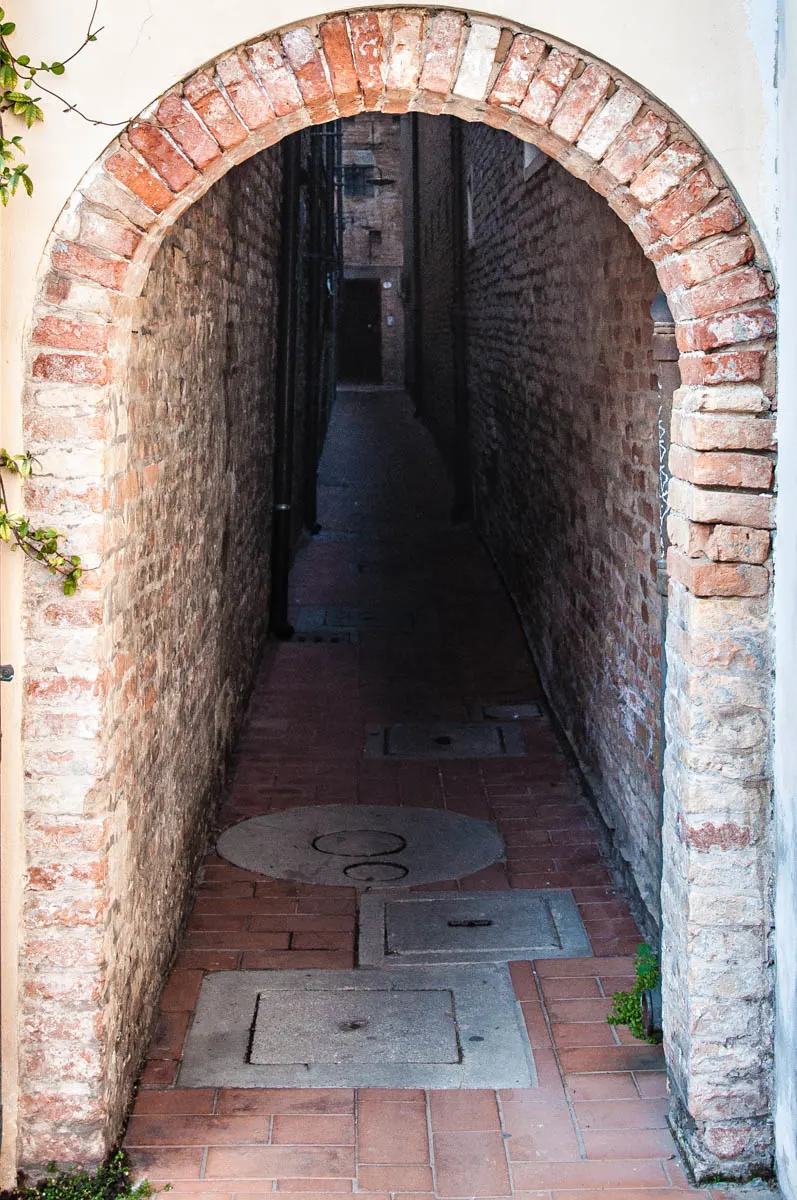
Another curious local sight is the very narrow Vicolo degli Amori (Lovers’ Lane) which is paved in terracotta and dates back to the 17th century.
While Bagnacavallo’s main square is Piazza Liberta’ where you can see the village’s 13th-century tower and Neo-Classical Town Hall, for me and many others the main sight here is the Piazza Nuova. It was built in 1758 as Romagna’s first shopping centre and it has a perfectly elliptical shape.
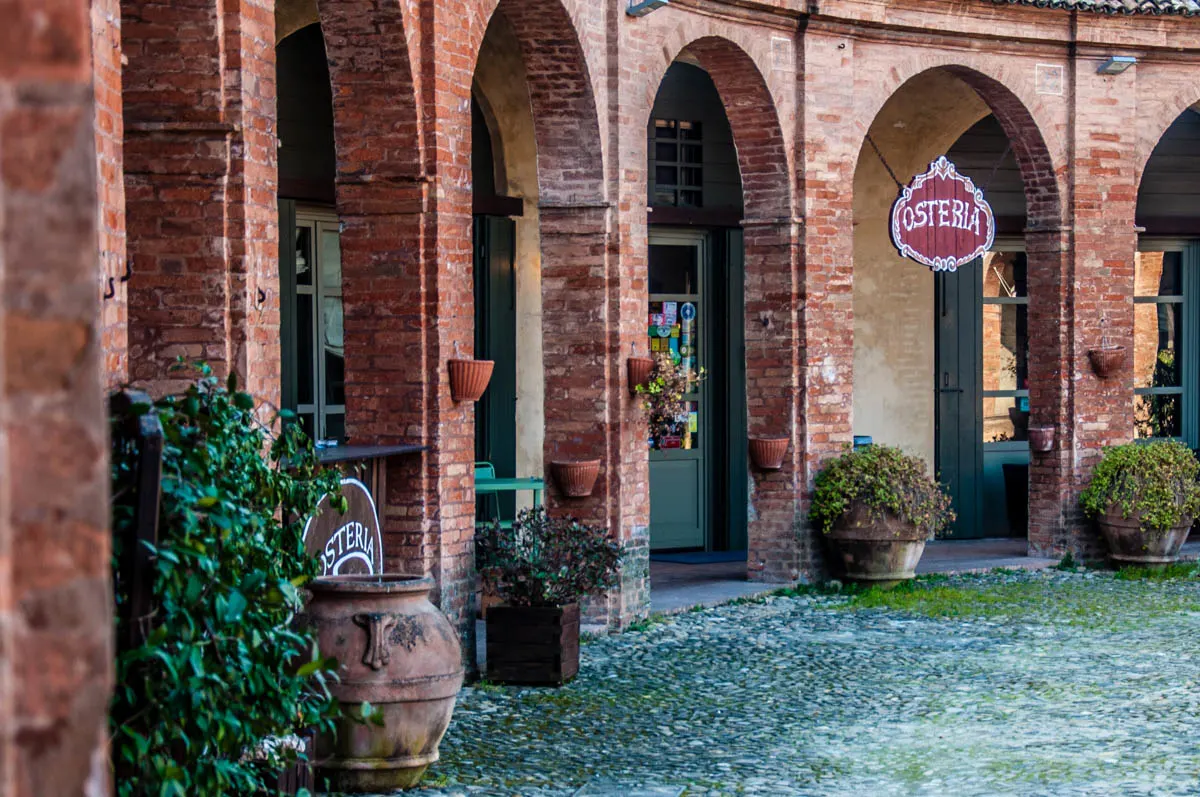
‘You must love a place where an 18th-century square is known as ‘the new one’!’, I told my husband as we stepped in the centre of Piazza Nuova to admire the portico with thirty arches that surround it on all sides.
Once housing butchers’, fishmongers’, and other retail shops and stalls, nowadays Piazza Nuova is home to numerous restaurants and bars. It also has been featured in several Italian films.
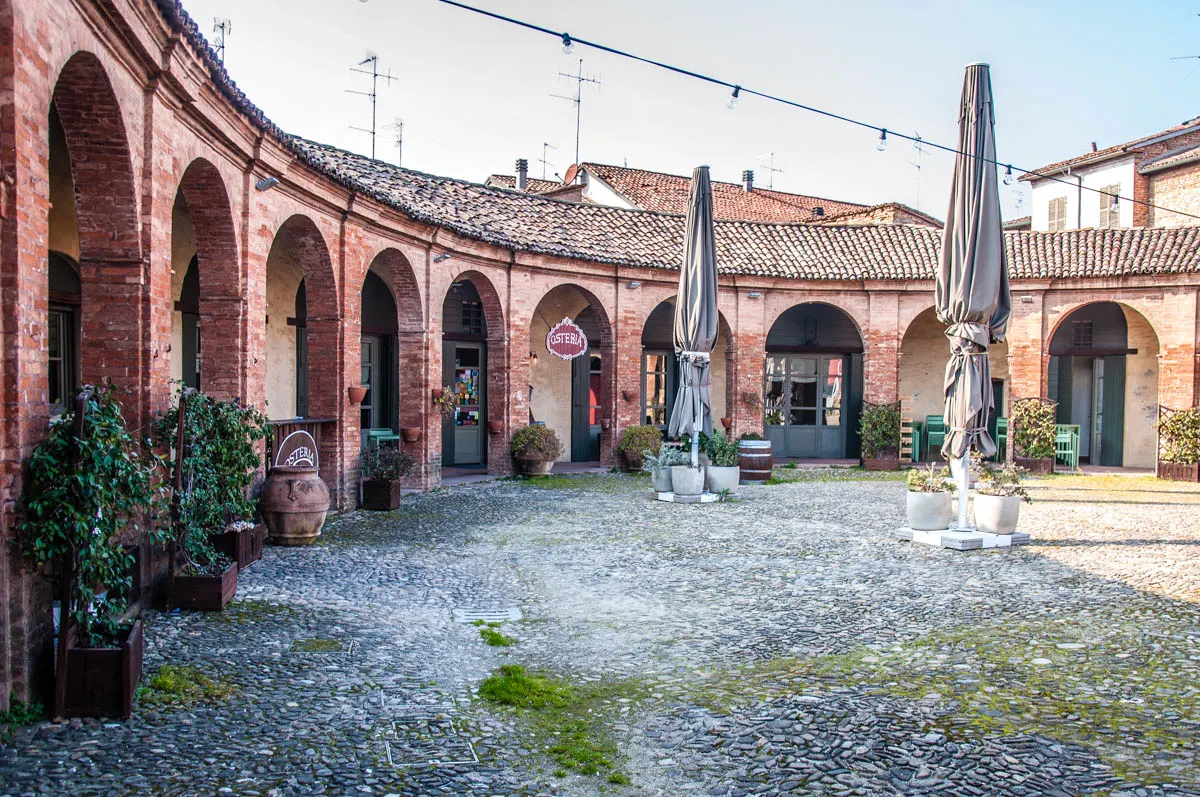
History and sights aside, for me Bagnacavallo’s charm is that the village – very much off the beaten path – gives you a chance to get close to the real Italy.
It doesn’t matter if you stop for a quick coffee and a walk through the village or if you spend a night or two here on the way to some more famous places in Emilia-Romagna or the nearby San Marino and Marche. Even in the shortest amount of time, you will feel Bagnacavallo’s relaxed and properly Italian atmosphere that’s so difficult to experience at Italy’s tourist hotspots.
What else to see nearby:
You can combine a visit to Bagnacavallo with the provincial capital of Ravenna (only 25 mins away). This is one of the most important cities in the region of Emilia-Romagna, Italy. Ravenna is worldwide famous for the splendid mosaics that grace the city’s Early Christian monuments. In the 5th and 6th centuries AD, the city was also the capital of the Western Roman Empire and then of the Ostrogothic Kingdom. To this day, Ravenna remains a centre of excellence in terms of mosaic art. Plus, the city has a number of exciting museums, it houses Dante’s final resting place, and it has a rich programme of festivals and other cultural events.
Bagnacavallo is only 35 mins away from Brisighella – another entry on this list of the five most beautiful villages in Emilia-Romagna. So, you can spend a day splitting your time between the two thus enjoying double the beauty and the history of this corner of Italy.
Bagnacavallo is respectively between 20 mins and just under 45 mins away from Faenza, Forli, and Cesena – smaller cities in Emilia-Romagna which are nevertheless rich in history and sights to see. Faenza, for example, is particularly famous for the local ceramics to the point that the term for glazed ceramics – faience – is derived from its name.
Finally, Bagnacavallo is around 45 mins away from Emilia-Romagna’s capital – the city of Bologna.
Alternatively, Bagnacavallo can be a nice pitstop on the way to San Marino (around 1 h 10 mins away) and to the neighbouring Italian region of the Marche (around 1 h 15 mins to Pesaro and 1 h 40 mins to Urbino).
More information:
- Ravenna, Italy – 10 Stories to Make You Want to Visit the City of Mosaics Now
- San Marino – A Travel Guide to the Oldest Republic and the Fifth Smallest Country in the World
- Marche, Italy – 6 Reasons to Visit Italy’s Most Underrated Region
Bobbio, Province of Piacenza
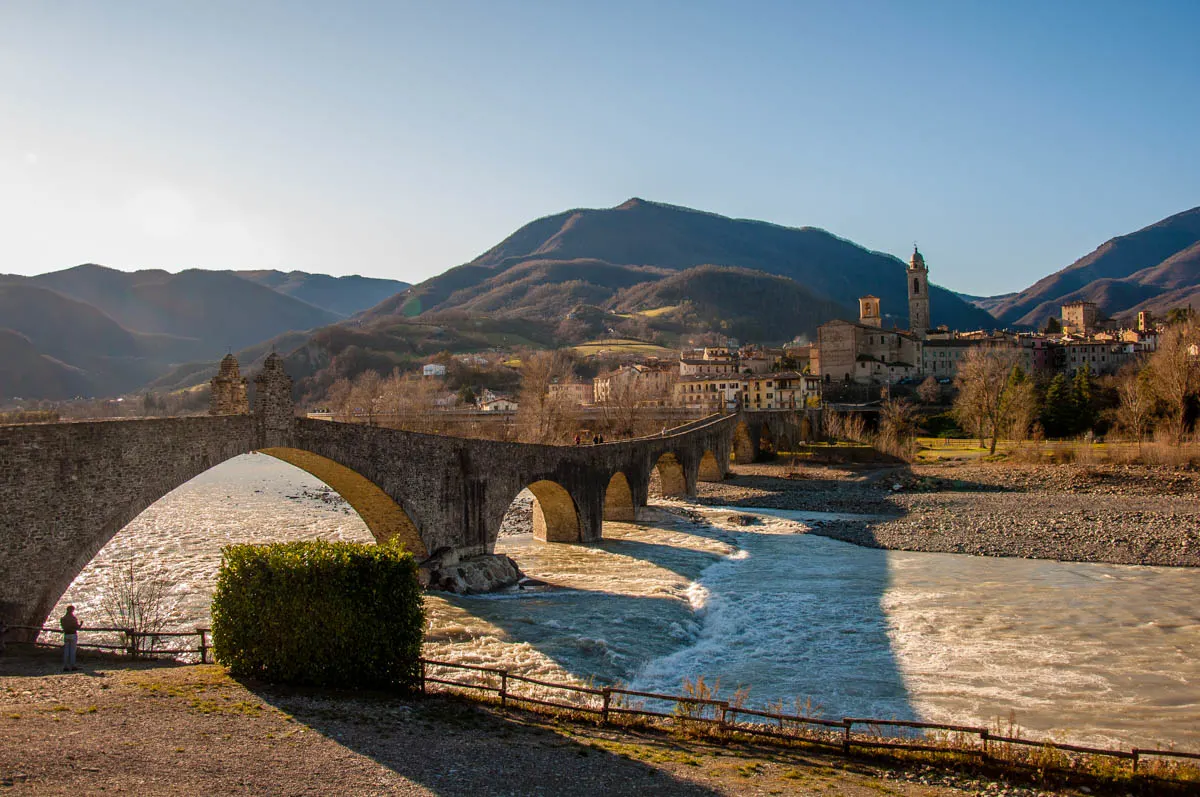
I came to visit Bobbio by pure chance. My husband, daughter, and I were spending a few days in Piacenza just before Christmas 2019. We were visiting Christmas markets and medieval castles in the small towns and villages in the lands surrounding this city in Emilia-Romagna just pleasantly whiling away the time when someone said: ‘You should go to Bobbio, too! It’s been elected as Italy’s most beautiful village for 2019 and it’s really rather nice!’
When we discovered that, allegedly, Leonardo da Vinci finished painting his famous Mona Lisa in Bobbio and that it is thought that the landscape behind this most iconic female face may be actually the area surrounding the village of Bobbio itself, we couldn’t get there fast enough.
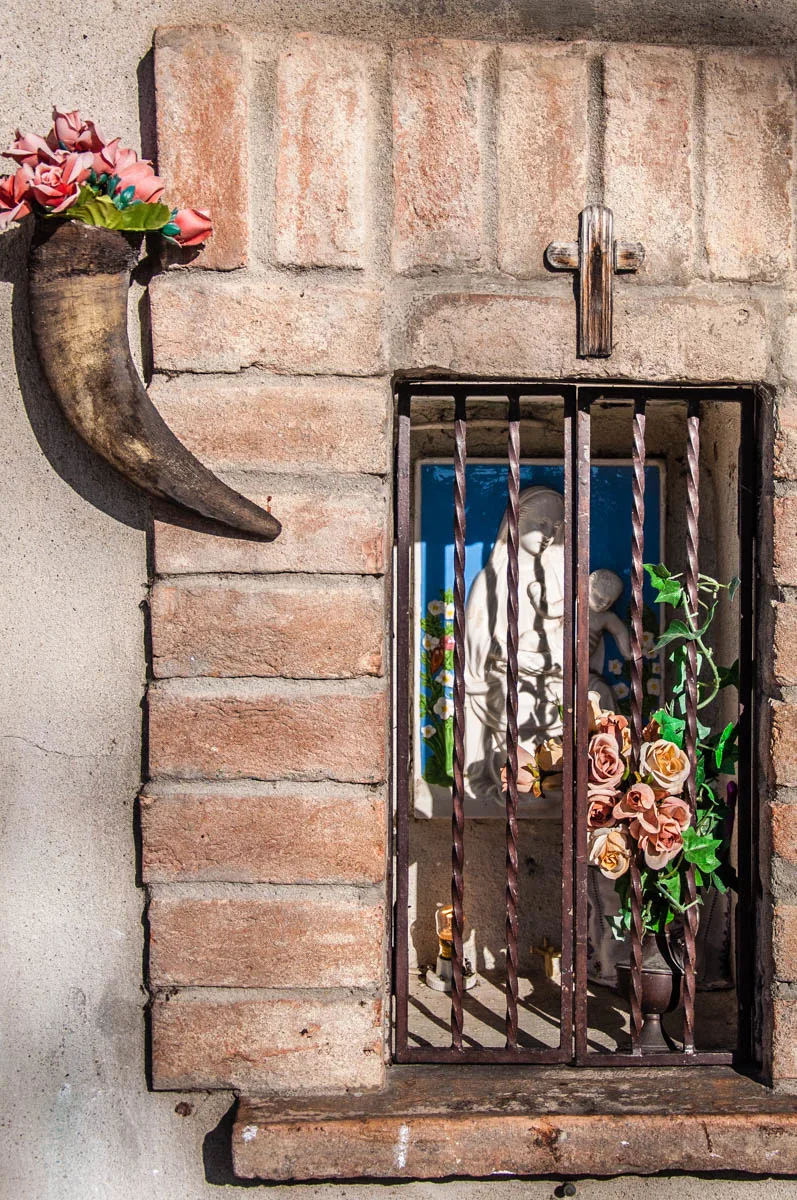
After a pleasant drive through the lush Val Trebbia (which, allegedly, the writer Ernest Hemingway proclaimed to be ‘the most beautiful in the world’), we reached the picturesque village of Bobbio. Spread at the base of the Monte Penice and standing on the shores of the river Trebbia, Bobbio doesn’t reveal all of its secrets at once.
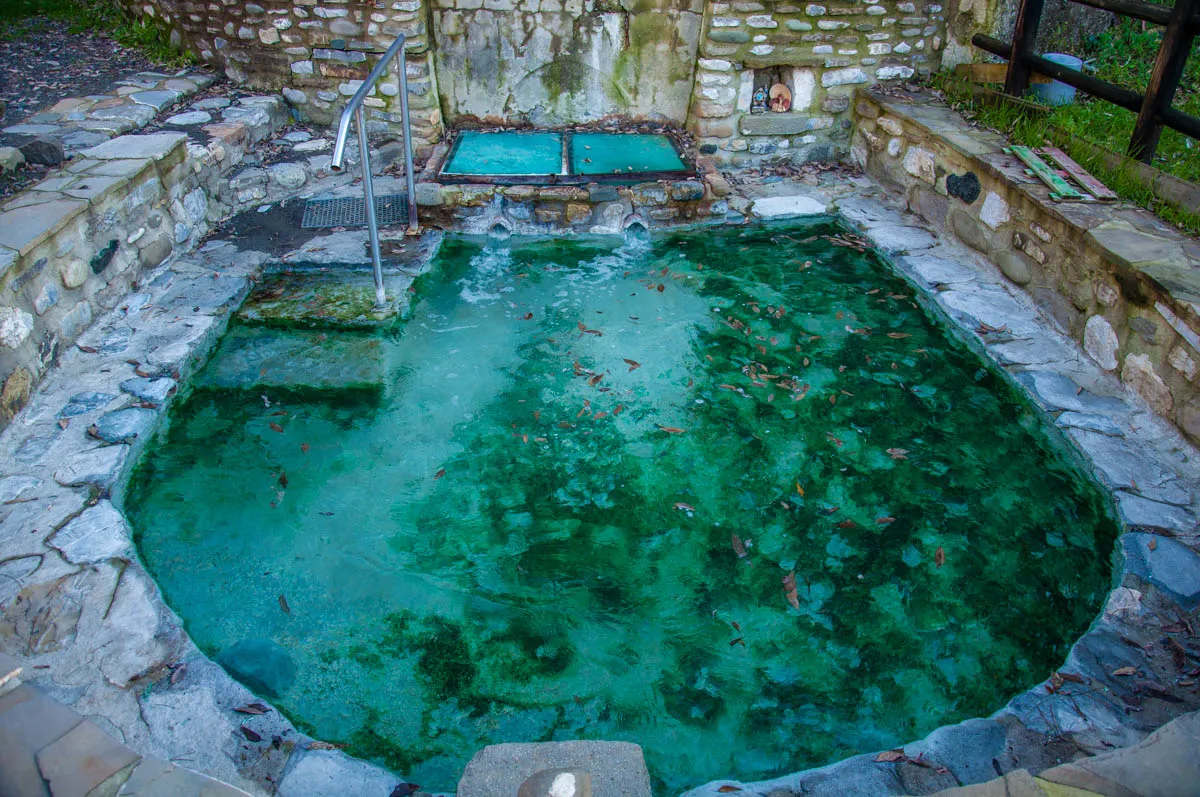
At first glance, it looks like you will be able to see it all there is to see in an hour and then drive off in search of new destinations and curious spots. Yet, with every step you take in this small Italian village, new surprises await for you. It could be the 12th-century mosaics in the Basilica of San Columbanus. Or the medieval castle that stands on top of a small hill and overlooks the village’s old stone houses. Or it could be the thermal spring on the opposite shore of the River Trebbia.
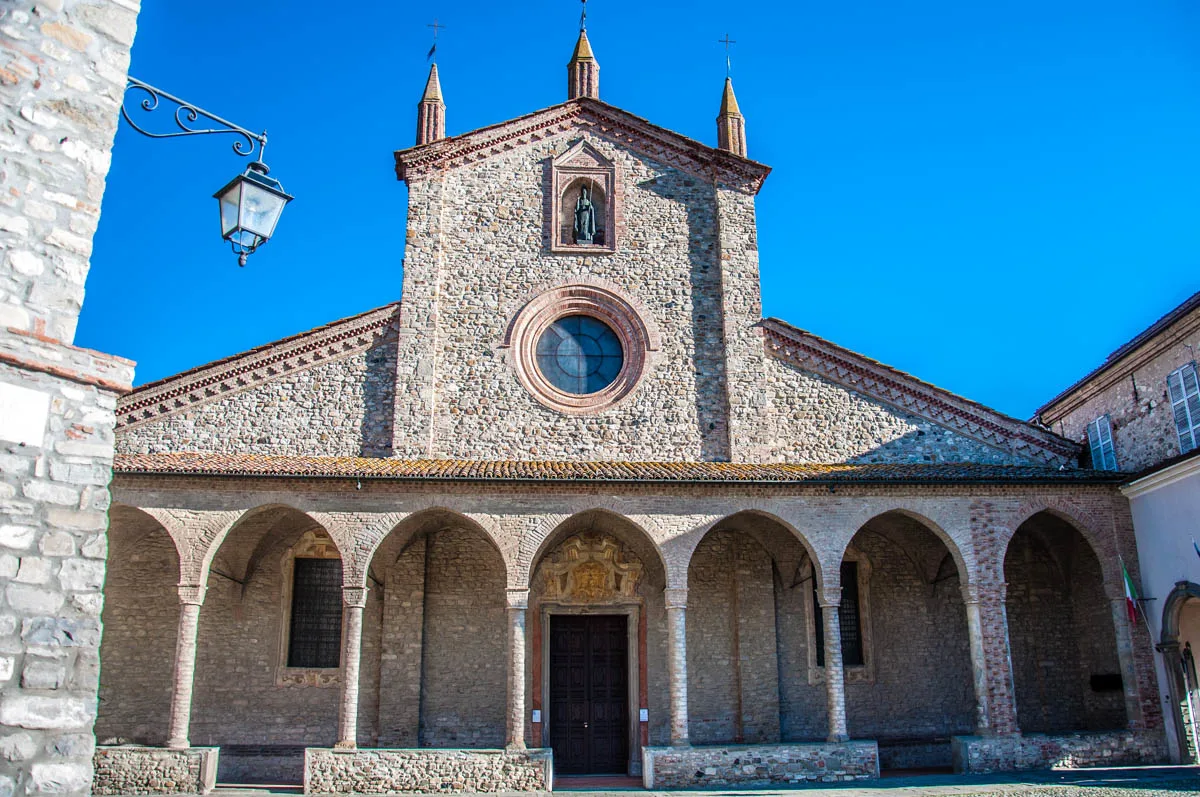
And when you consider that Bobbio’s Benedictine Abbey was in fact founded in 614 by the Irish monk and missionary St. Columbanus and then it grew to be one of the most important religious centres of the Middle Ages, you understand how old are those lands and the stories and traditions of the people who live there.
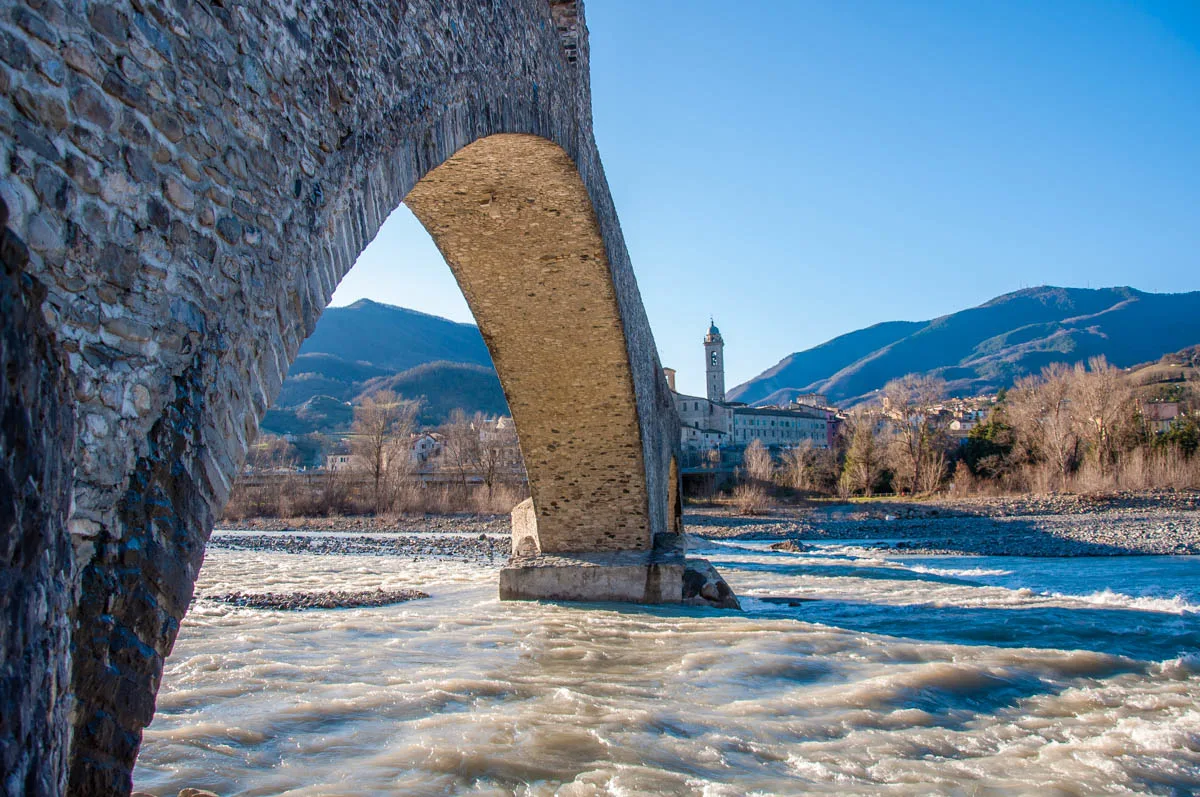
The most visually stunning thing about Bobbio is its bridge. It’s known under three different names – Ponte Gobbo (Hunchback Bridge), Ponte Vecchio (Old Bridge), and Ponte del Diablo (Devil’s Bridge). It unfurls its eleven arches of differing spans over the river Trebbia and offers great photo opportunities with the river’s fast-running waters and Bobbio’s old houses as a stunning backdrop. Trust me, you won’t be able to put your camera down.
Especially, when you think that this probably is the bridge depicted by Leonardo da Vinci by the left shoulder of Mona Lisa (according to a book by the Italian scholar Carla Glori). A bridge has existed at that spot since Roman times. The current structure goes as far back as the 7th century. Its appearance has changed several times since then though. The bridge’s arches were badly damaged or destroyed by river floods many times over the centuries. They were then re-built and new arches were added thus giving the bridge its unusual hunchback appearance.
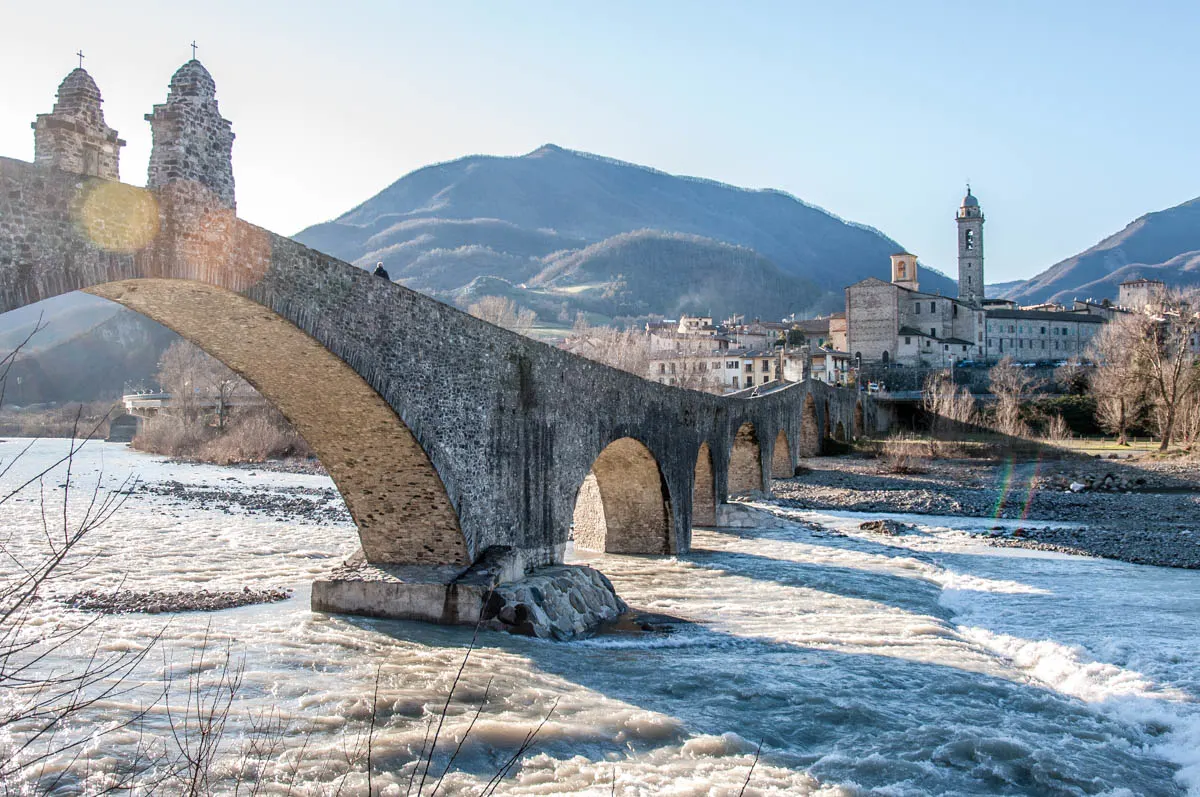
According to a popular local legend, it was San Columbanus who challenged the Devil to build a bridge across Trebbia in one night in exchange for the soul of the first passerby to cross it in the morning. The Irish Saint then let a dog walk across the bridge as soon as the roosters greeted the dawn.
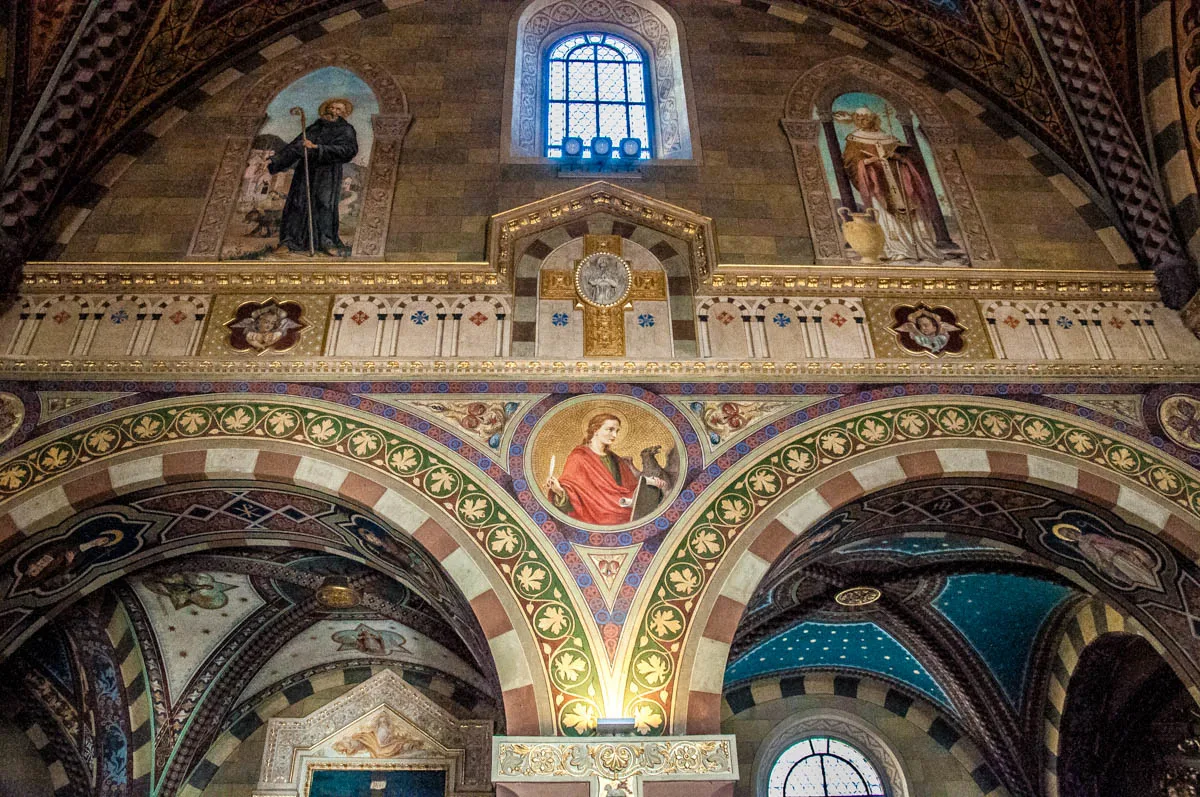
Curious legends, stunning views, great sights… Bobbio is a must-see village in the Italian region of Emilia-Romagna.
It’s also famous for its snails which are prepared according to a centuries-old recipe. I must admit, this was the only thing I didn’t tick off in Bobbio. If you are culinarily more adventurous than me, make sure that you do it.
What else to see nearby:
Bobbio is next door to a handful of other small ancient villages in the area and with its location at the base of Monte Penice of the Ligurian Apennines, it gives endless opportunities for hiking, skiing, and getting close to nature.
You can also combine a visit to Bobbio with the provincial capital of Piacenza (50 mins away). This is one of the most important cities in the region of Emilia-Romagna, Italy. With Etruscan, Gaul, and Roman roots, Piacenza nowadays has many sights, palaces, and churches to entice the curious traveller and a renowned local cuisine centred around pork, polenta, and wine.
Bobbio is just over 35 mins away from Grazzano Visconti and just over 1 hour away from Castell’Arquato – another two entries on this list of the five most beautiful villages in Emilia-Romagna. So, if you are a speedy sightseer, you can theoretically spend a long day splitting your time between the three thus enjoying triple the beauty and the history of this corner of Italy. If you can help it, don’t rush it though as there is much to see in all three of them.
Bobbio is just over 1 h 30 mins away from Parma – another important city in Emilia-Romagna that is worldwide famous for its culinary traditions.
Alternatively, Bobbio can be a nice day trip from the neighbouring regions of Lombardy (1 h 15 mins from Cremona and 1 h 30 mins from Pavia) and Liguria (just under 2 h from Genoa).
Brisighella, Province of Ravenna
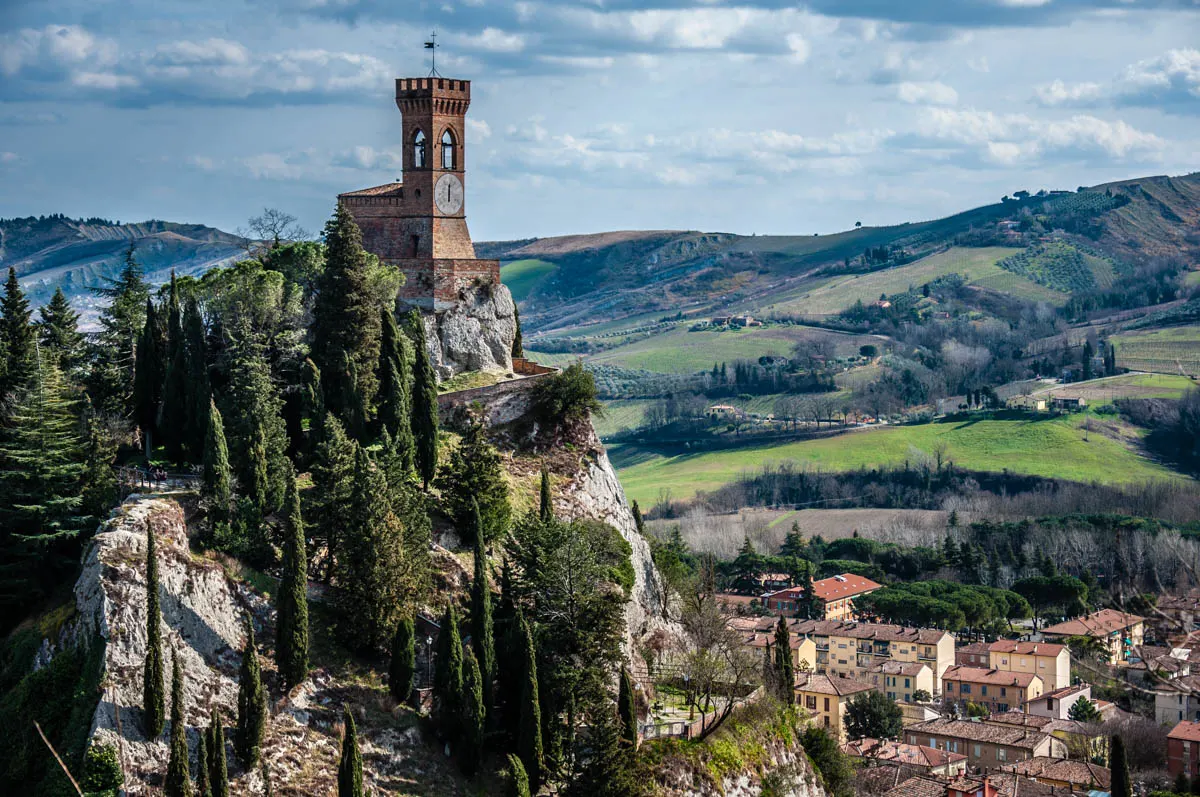
Brisighella stole my heart! Walking up the village’s steep cobbled streets, looking up at its tall faded facades in once bright colours, taking in the stunning landscape from its hilltop clocktower filled me with peace and profound happiness to be there at that very moment in time when nothing else mattered but the blue sky above me and the beauty of the village I was in.
I could have happily spent a week in Brisighella but I only had a day and a night there so here is hoping that I will have a chance to return.
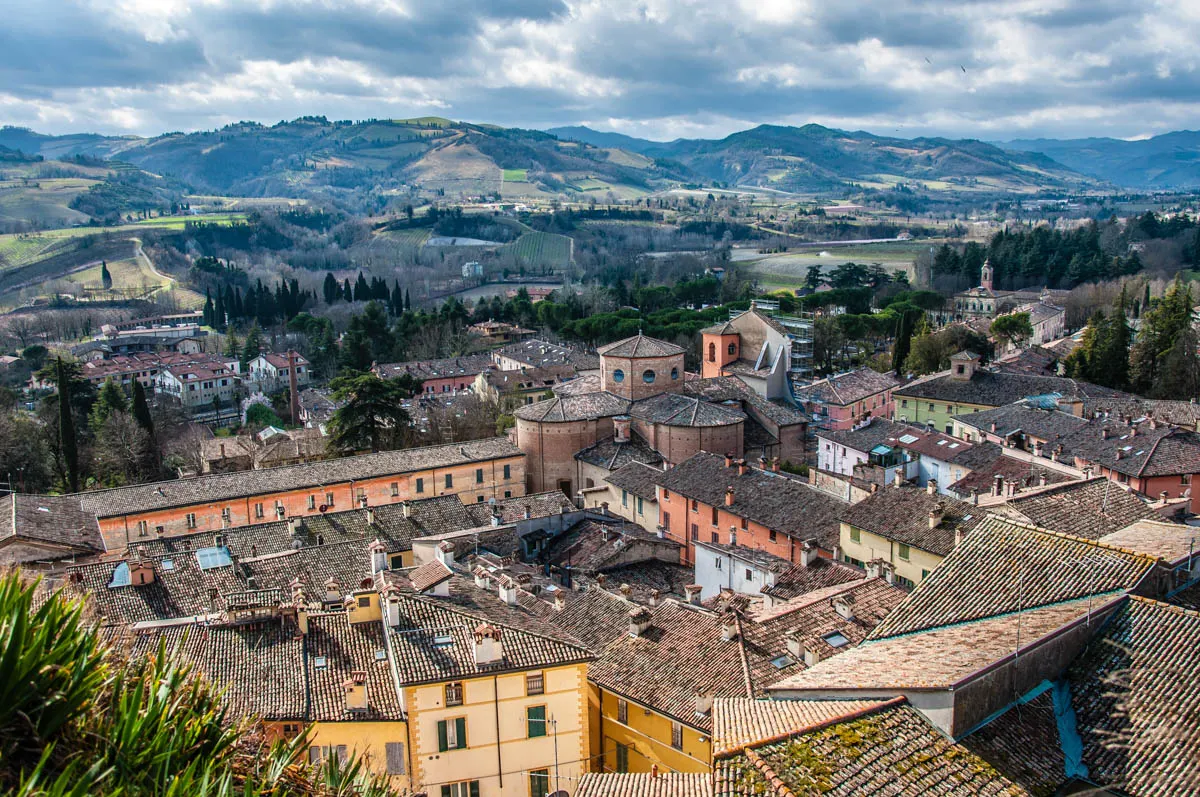
What attracted me originally to this village in Emilia-Romagna was its elevated covered street. It’s a unique type of street that is above the level of the road and runs inside a long row of houses.
I had only seen anything like this in Chester where the Rows are one of the most important and interesting sights of this British city.
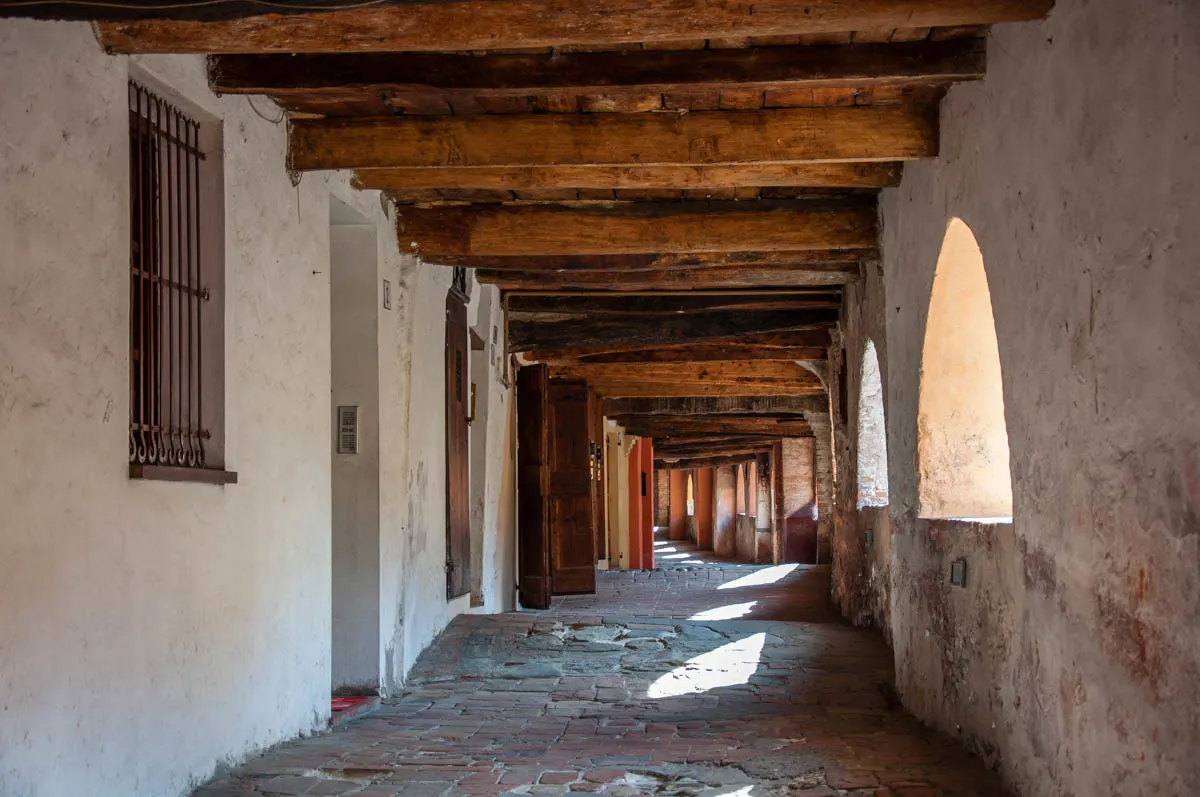
Called Via degli Asini (Donkeys’ Road), the elevated covered street of Brisighella didn’t disappoint. It was not lined up with shops and cafes like the Rows in Chester but it looked ruggedly authentic.
Originally a defensive patrol way, this elevated path was later covered thus becoming part of the row of houses. It’s illuminated via a long line of lunette windows that runs along the houses’ facades.
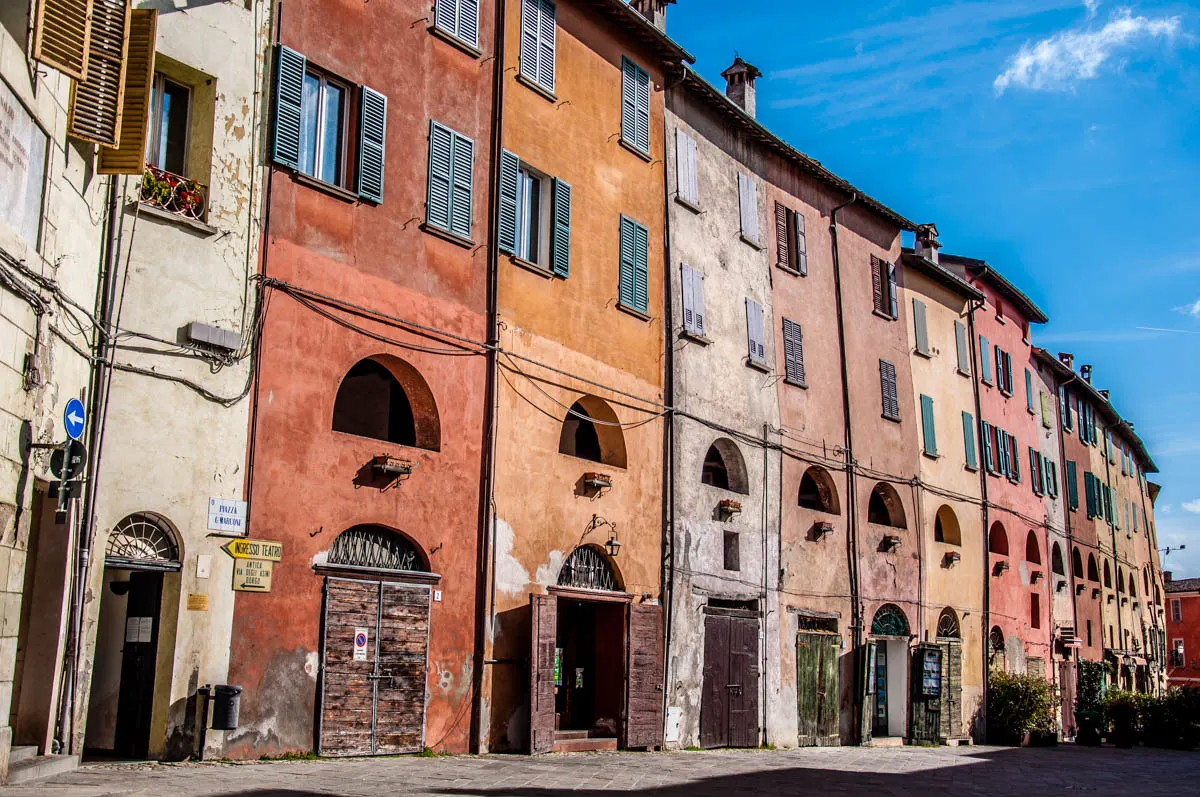
Via degli Asini owes its name to the donkeys that were used to transport the gypsum from the nearby quarries for the area surrounding Brisighella is rich in this natural material.
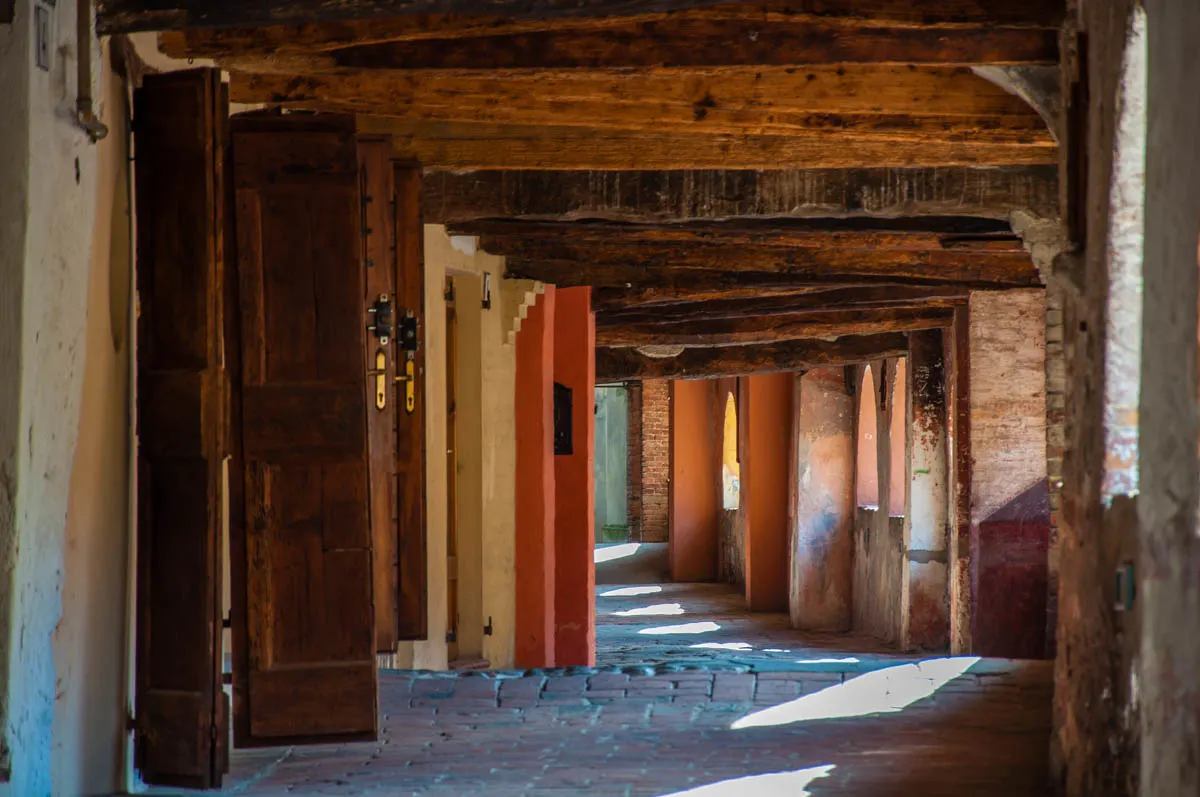
Apart from Donkeys’ Road, there are many more things to do in Brisighella. Just walking around gives you an authentic look into life in a medieval Italian village. You can feel and see the wear and tear of time and the many ways that our modern life has had to adapt to houses and streets that were built when carts were the measure for accessibility.
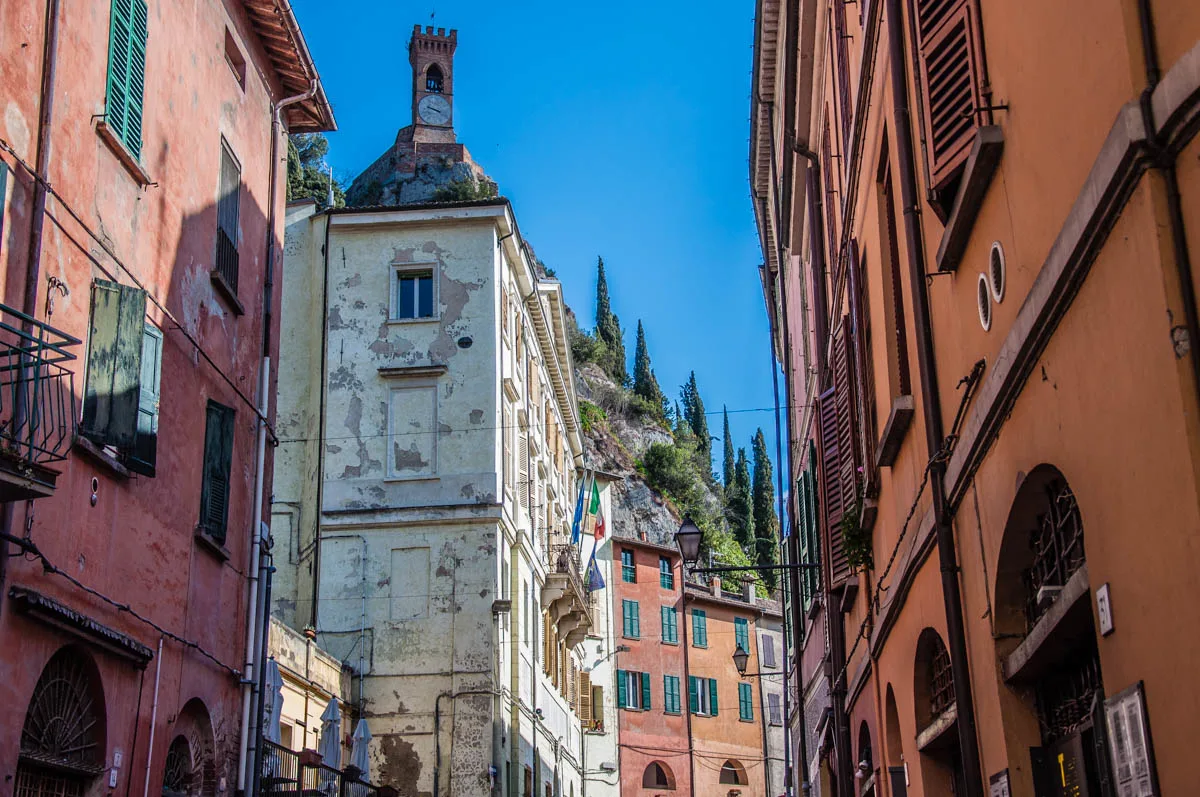
Nothing is pristine in Brisighella. Nothing has been polished and made look perfect in the eyes of a busload of tourists. And that’s the charm of this village in Emilia-Romagna.
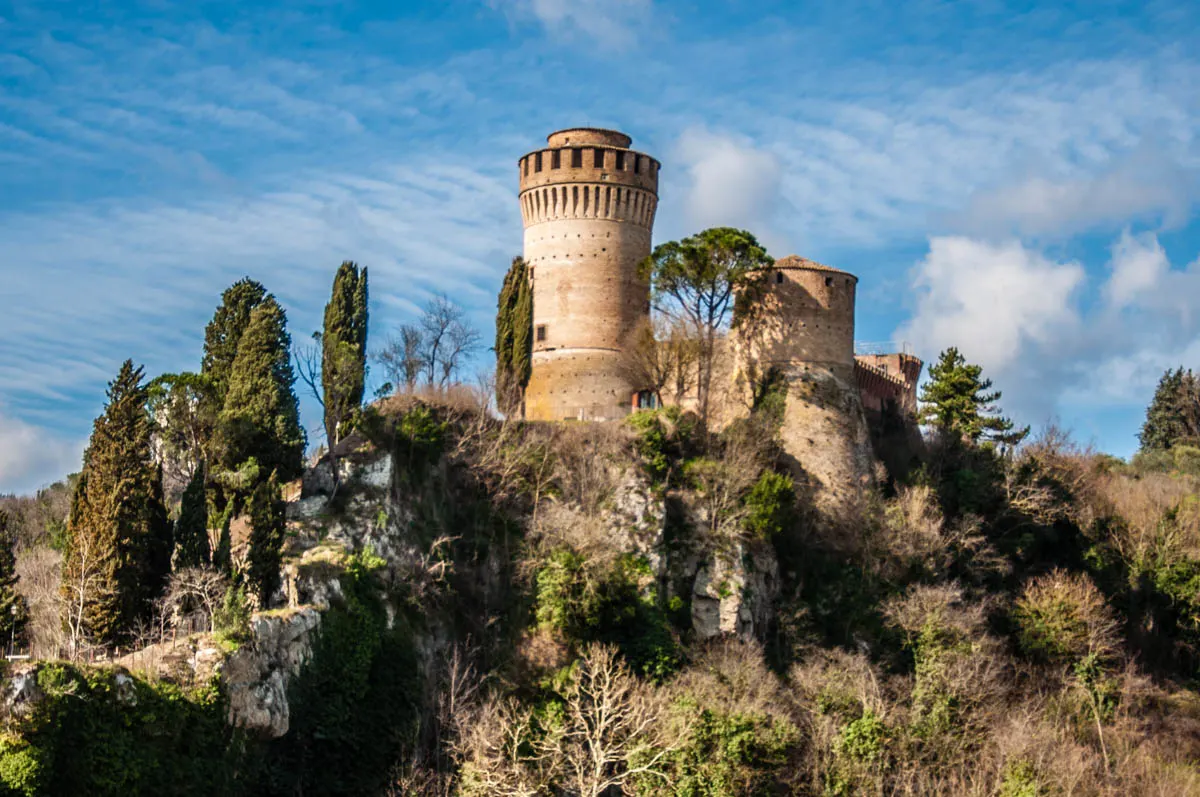
If you find yourself here, don’t miss the 13th-century fortress with its cylindrical towers, the 19th-century clocktower that was built on the foundations of a 13th-century fortification, the village’s several churches and a handful of museums. Take in the stunning views that open from both the fortress and the clocktower and walk the path that leads from one to the other past olive groves and vineyards.
Then treat yourself to a lovely lunch or dinner in one of Brisighella’s trattorias and restaurants letting the food of Emilia-Romagna talk to your body and soul between delicious bites.
What else to see nearby:
Brisighella is on the edge of the Gypsum Vein of Romagna Regional Park – a historic and natural landscape giving you endless hiking explorations.
You can also combine a visit to Brisighella with the provincial capital of Ravenna (just over 50 mins away). This is one of the most important cities in the region of Emilia-Romagna, Italy. Ravenna is worldwide famous for the splendid mosaics that grace the city’s Early Christian monuments. In the 5th and 6th centuries AD, the city was also the capital of the Western Roman Empire and then of the Ostrogothic Kingdom. To this day, Ravenna remains a centre of excellence in terms of mosaic art. Plus, the city has a number of exciting museums, it houses Dante’s final resting place, and it has a rich programme of festivals and other cultural events.
Brisighella is only 35 mins away from Bagnacavallo – another entry on this list of the five most beautiful villages in Emilia-Romagna. So, you can spend a day splitting your time between the two thus enjoying double the beauty and the history of this corner of Italy.
Brisighella is respectively between less than 20 mins and 50 mins away from Faenza, Forli, and Cesena – smaller cities in Emilia-Romagna which are nevertheless rich in history and sights to see. Faenza, for example, is particularly famous for the local ceramics to the point that the term for glazed ceramics – faience – is derived from its name.
Finally, Brisighella is around 1 hour away from Emilia-Romagna’s capital – the city of Bologna.
Alternatively, Brisighella can be a nice pitstop on the way to San Marino (around 1 h 20 mins away) and to the neighbouring Italian region of the Marche (around 1h 15 mins to Gradara and 1 h 25 mins to Pesaro).
More information:
- Ravenna, Italy – 10 Stories to Make You Want to Visit the City of Mosaics Now
- San Marino – A Travel Guide to the Oldest Republic and the Fifth Smallest Country in the World
- Marche, Italy – 6 Reasons to Visit Italy’s Most Underrated Region
Castell’Arquato, Province of Piacenza
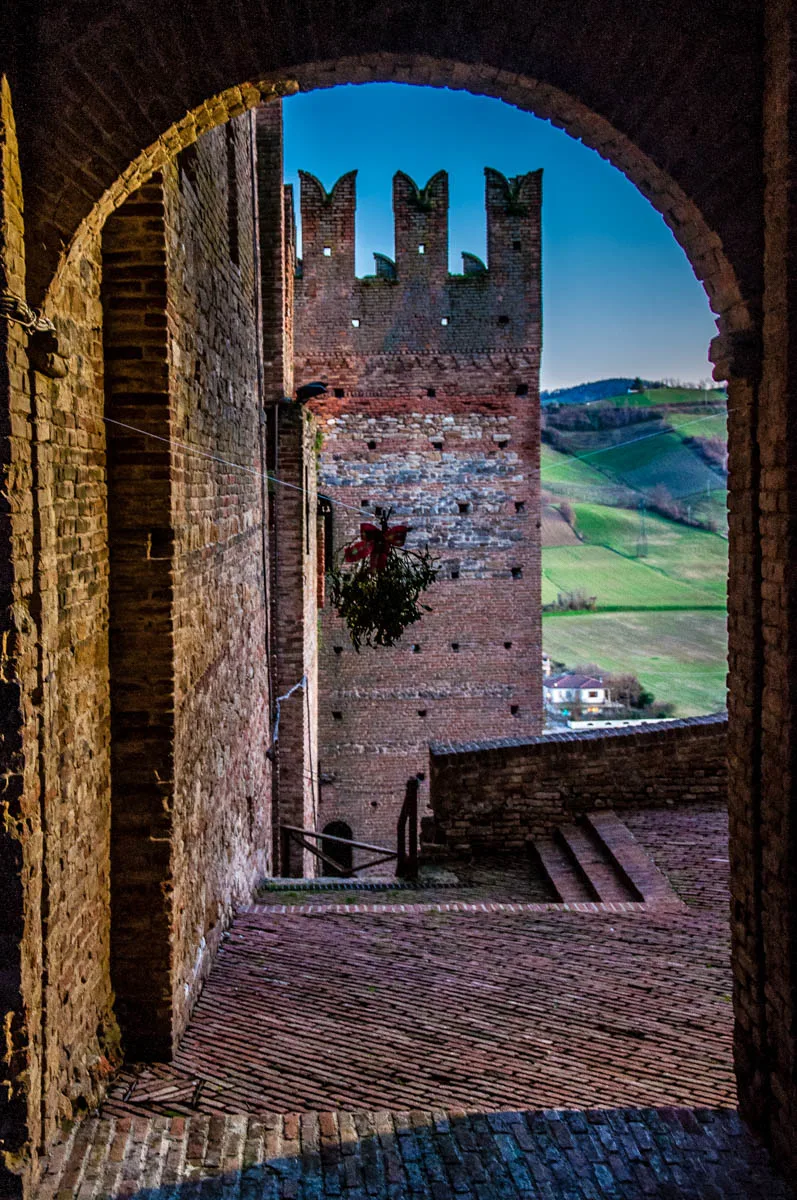
Glimpsing Castell’Arquato as you drive up the road, you will be forgiven if for a split second you thought that you’ve been transported to the Middle Ages and a group of knights would come galloping at you from just around the corner.
This village in Emilia-Romagna is truly stunning. A large hilltop castle commands the eye. Steep cobbled streets lead up to the top of the hill opening splendid views over the surrounding lush hills and taking you past tall houses and palaces. Here and there, the inclination of the terrain had been so challenging that instead of a street, you need to climb up stone steps to reach the village’s hilltop historic centre.
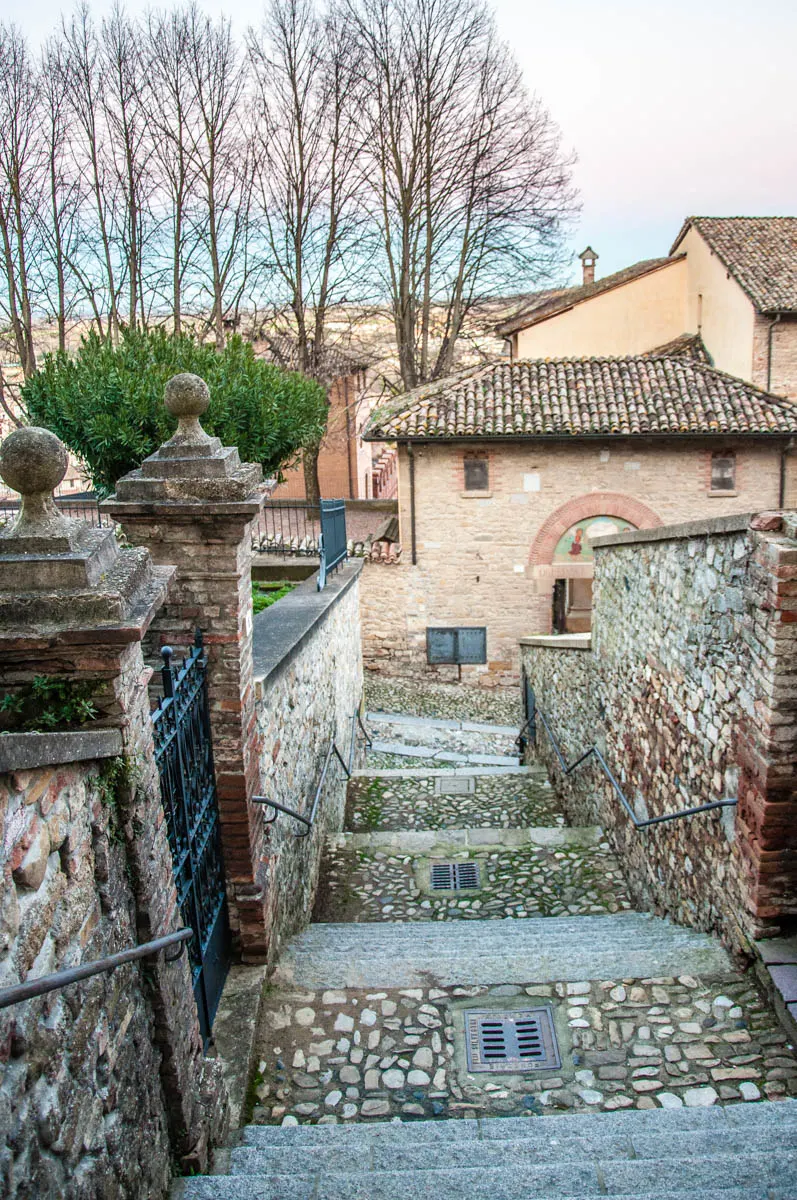
We arrived at Castell’Arquato at the end of a long day and just seeing its medieval castle and defensive walls against the quickly darkening sky is a memory that I will cherish forever. If you are of an age where most illusions you have once held have been broken by life’s forces, seeing this beautiful place will make you believe once again that fairytales are realistically possible.
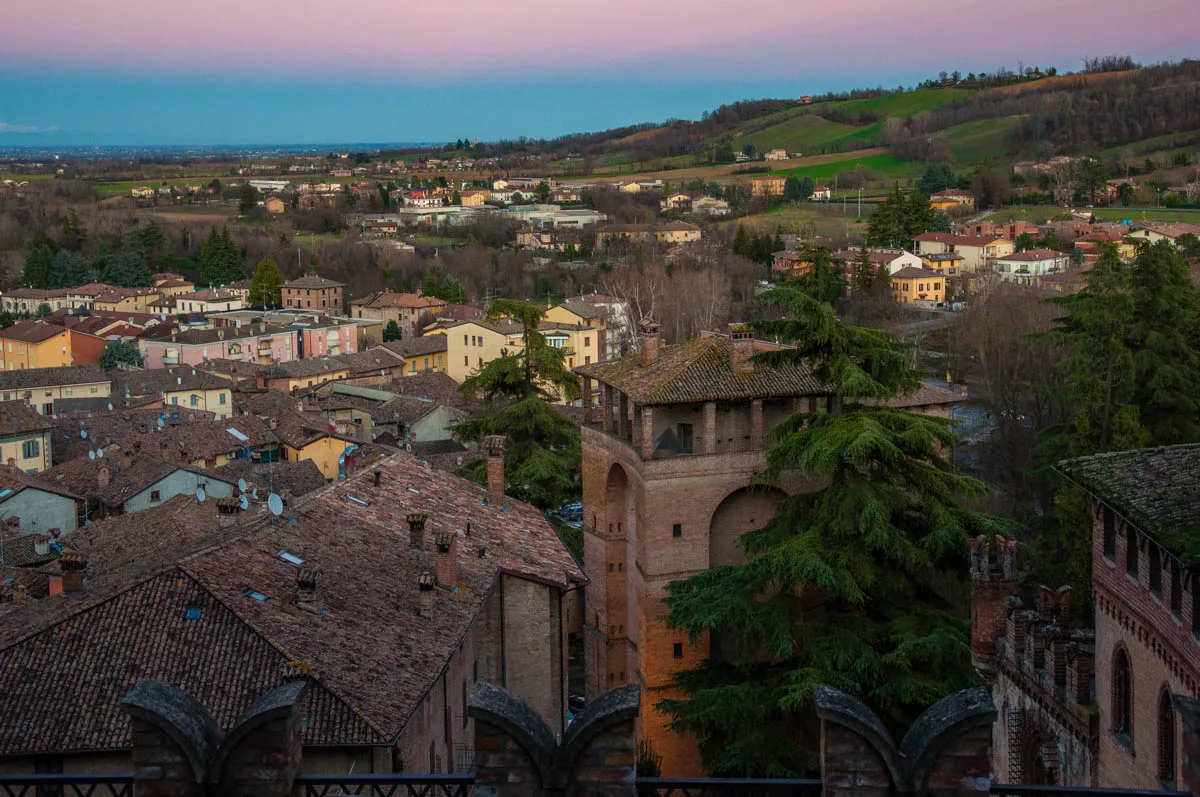
And while Castell’Arquato has many sights to tick off in a day, the best and major sight here is the village itself. Just walking around, up and down cobbled streets and stone steps, looking out at green undulating hills, touching stones that have spent centuries at the same place under the sun and moon of Emilia-Romagna is a great experience to have.
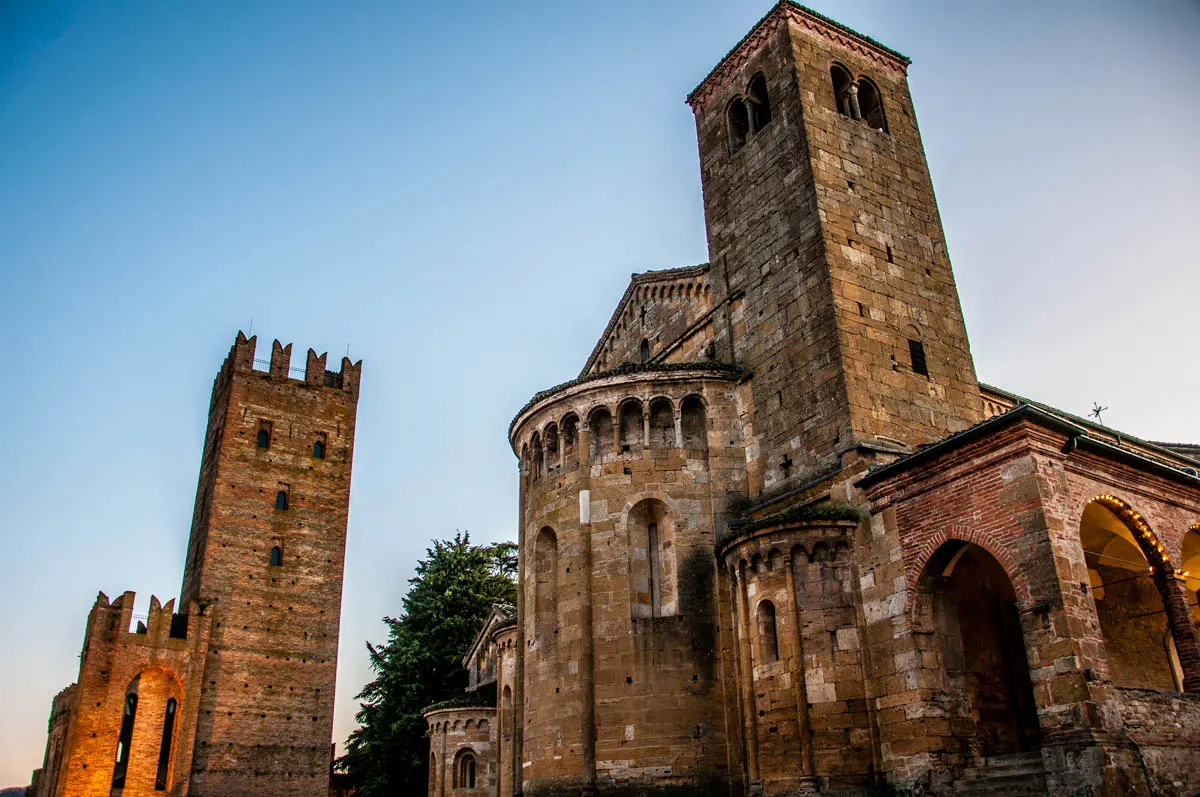
Give yourself the unhurried pleasure of walking around Castell’Arquato, of making slow steps, of taking narrow streets and seeing where they will lead you. You may glimpse a cat or two, a beautifully tended garden, a view that will take your breath away.
All precious fleeting moments to remember with love in the days ahead.
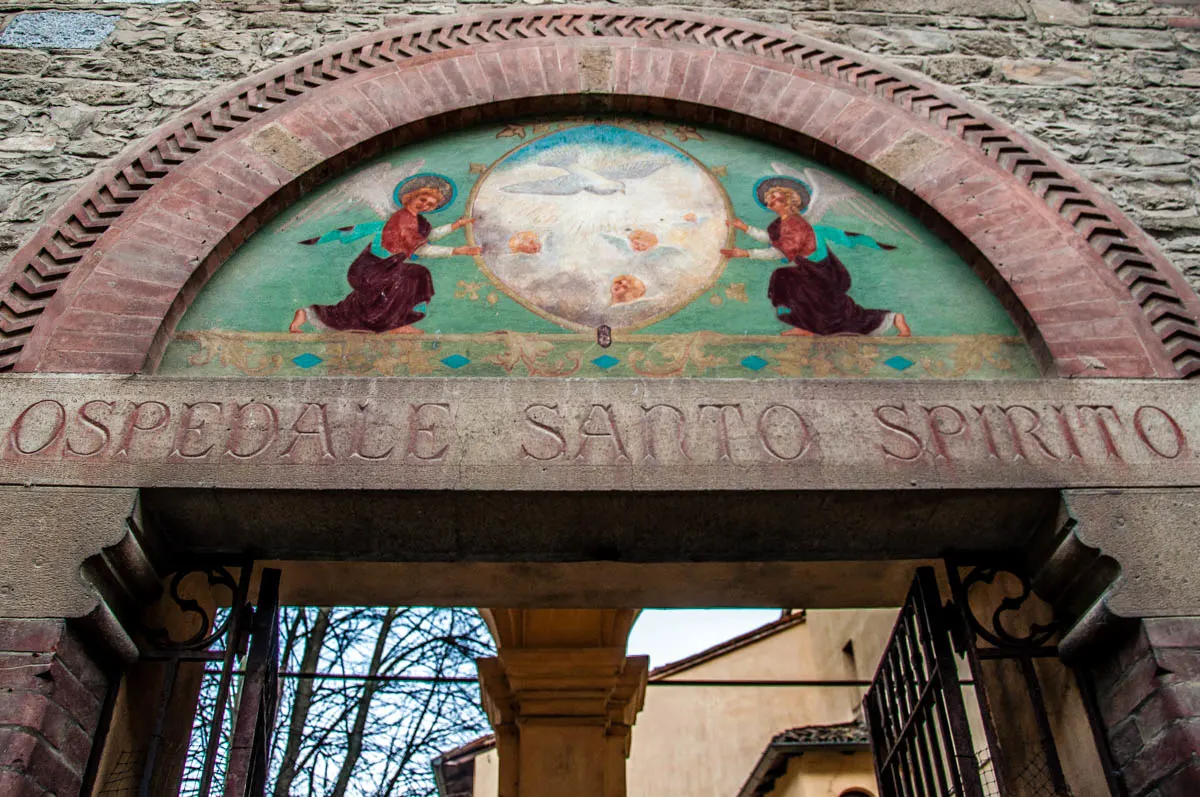
Still, for your travel wish list, here are some of the main sights to tick off when in Castell-Arquato in Emilia-Romagna: the Visconti Castle with the Medieval Museum, the Collegiata Church of St. Mary, the Palazzo del Podesta’, the Ducal Palace, and the Geological Museum which is housed in a former hospital.
If you like opera, you may be pleasantly surprised to discover that Giacomo Puccini’s and Pietro Mascagni’s librettist – Luigi Illica – was born in Castell’Arquato and is buried there. Illica wrote the librettos for such famous operas as Tosca, Madama Butterfly, and La Boheme.
Then again, Castell’Arquato is like music for the eyes!
What else to see nearby:
You can combine a visit to Castell’Arquato with the provincial capital of Piacenza (just under 40 mins away). This is one of the most important cities in the region of Emilia-Romagna, Italy. With Etruscan, Gaul, and Roman roots, Piacenza nowadays has many sights, palaces, and churches to entice the curious traveller and a renowned local cuisine centred around pork, polenta, and wine.
Castell’Arquato is just under 35 mins away from Grazzano Visconti and just over 1 hour away from Bobbio – another two entries on this list of the five most beautiful villages in Emilia-Romagna. So, if you are a speedy sightseer, you can theoretically spend a long day splitting your time between the three thus enjoying triple the beauty and the history of this corner of Italy. If you can help it, don’t rush it though as there is much to see in all three of them.
Castell’Arquato is just over 45 mins away from Parma – another important city in Emilia-Romagna that is worldwide famous for its culinary traditions. Finally, Castell’Arquato is around 1 hour 40 mins away from Emilia-Romagna’s capital – the city of Bologna.
Alternatively, Castell’Arquato can be a nice and easy day trip from the neighbouring region of Lombardy (35 mins from Cremona, 1 h 15 mins from Pavia, and 1 h 30 mins from Milan).
Grazzano Visconti, Province of Piacenza
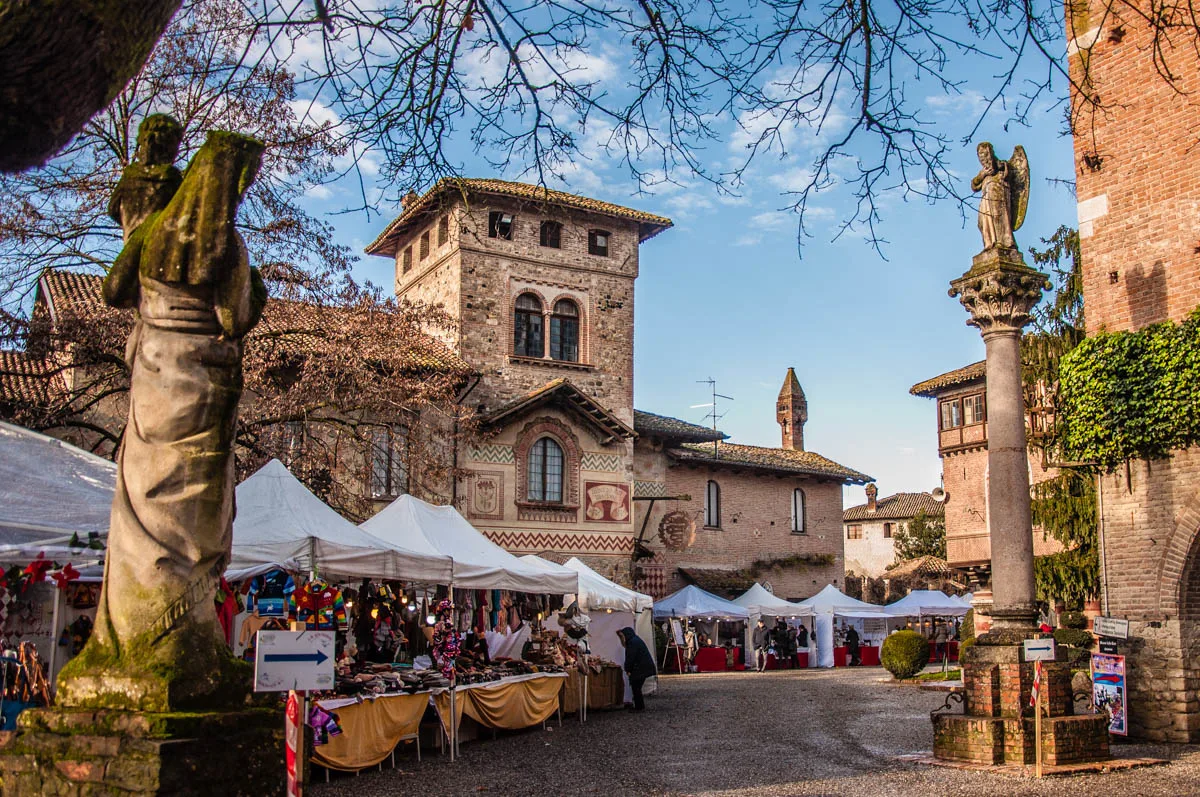
Grazzano Visconti is one of the most whimsical and colourful places I have had the chance to visit in Italy. You will find this Neo-Gothic village near the city of Piacenza in Emilia-Romagna.
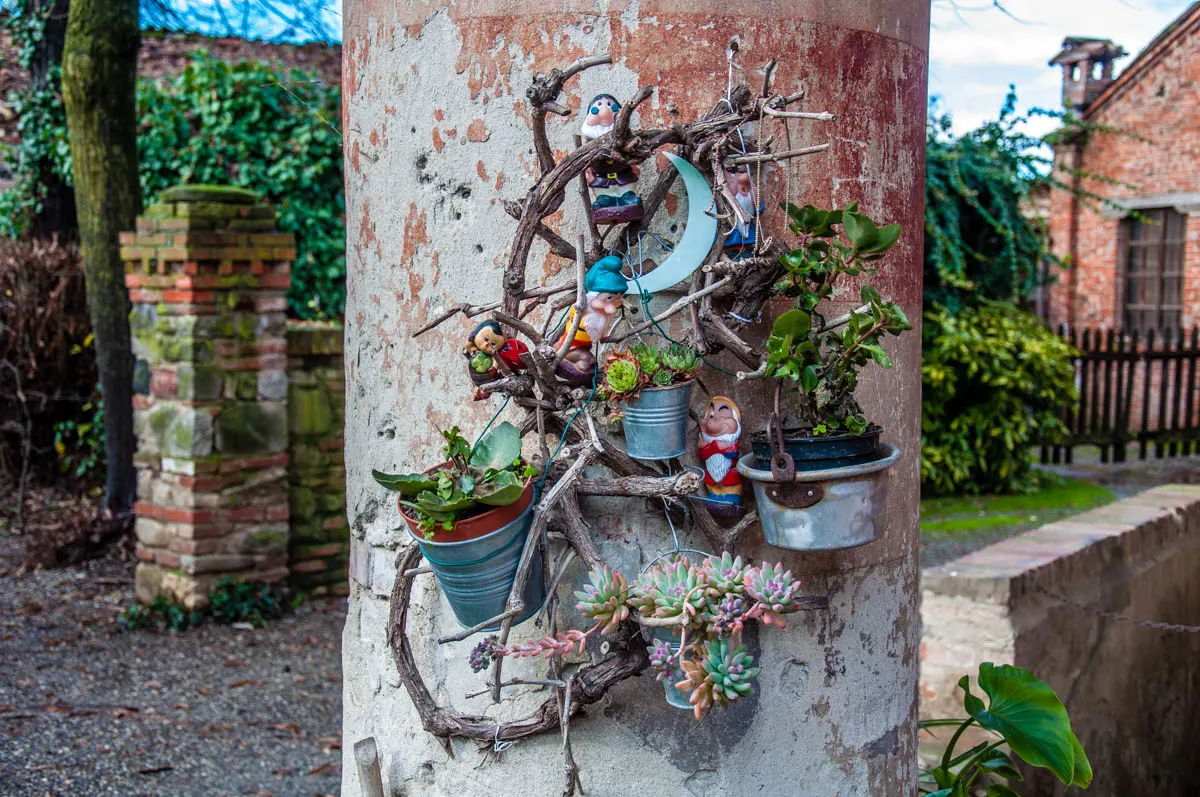
Grazzano’s history dates ten centuries back in time and it is intrinsically connected to one of the noblest Italian dynasties – the Visconti – who ruled Milan and its adjacent territories in the Middle Ages. By the beginning of the 20th century though, the village’s ancient castle had been reduced to ruins with only a handful of small poor houses around it still standing.
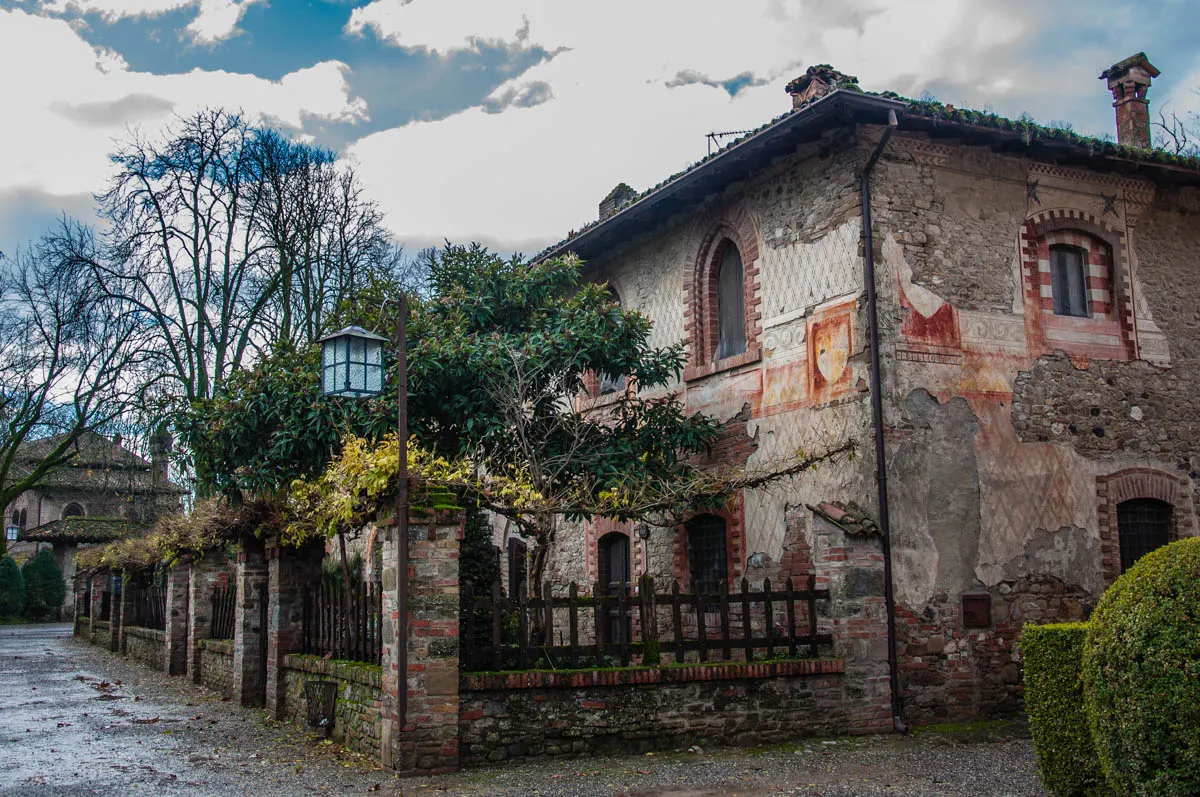
Enter Count Giuseppe Visconti di Modrone – a descendant of the medieval Visconti – and also an entrepreneur and an artist at heart. He rebuilt both the village of Grazzano Visconti and its castle turning them into a Neo-Gothic dream.
So invested was the count in his project, that he personally painted the frescoes that to this day adorn the village’s facades.
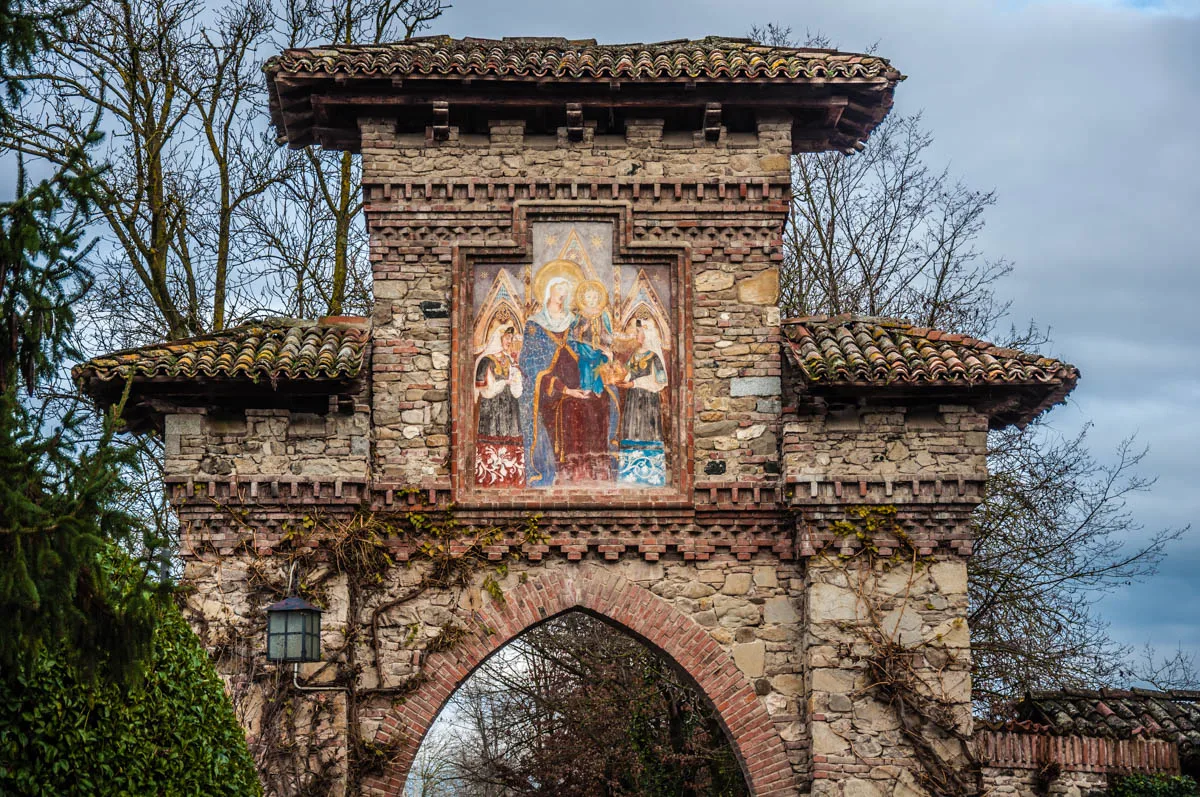
In the process, Giuseppe Visconti created work opportunities for the local population, revived ancient crafts, and even founded an arts and crafts school.
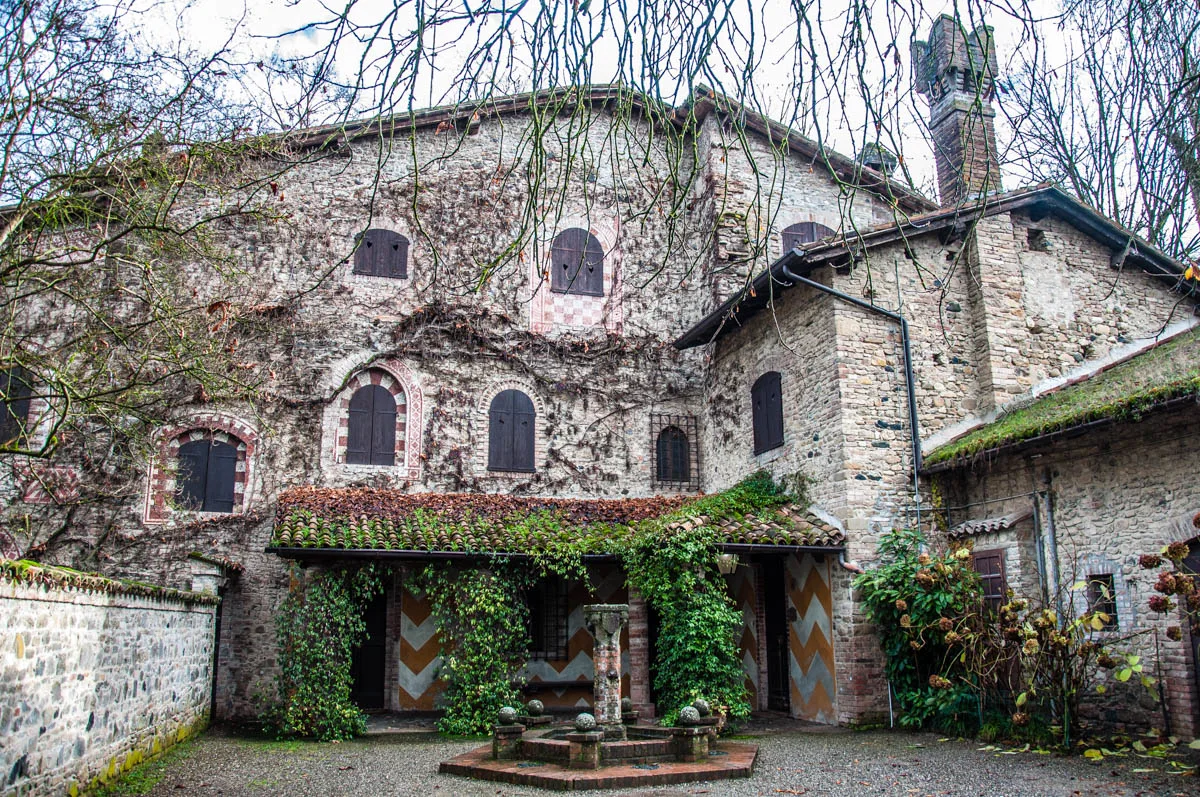
Visiting Grazzano Visconti feels like being transported back in time. The colourful houses, the craftsmen working in the different workshops, the lively festivals that are regularly held here, the unpaved streets, the complete lack of cars (you need to leave your vehicle at the large car parks next to the village’s entrances), it all feels like one big magical fairground for little ones and grown-ups.
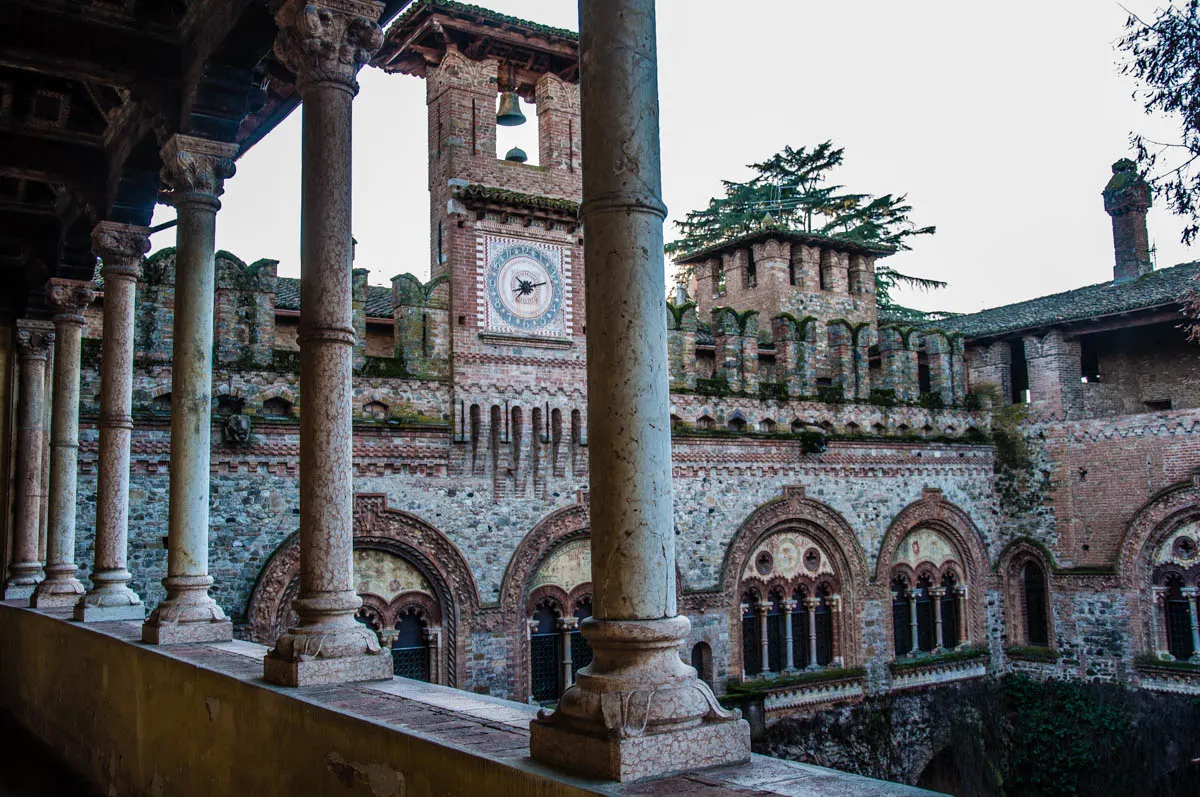
My favourite bit about visiting Grazzano Visconti in Emilia-Romagna was the guided tour of the castle that Count Giuseppe Visconti had rebuilt. Full of priceless works of art and crafts from all corners of the world and having its own resident ghost, the castle is a great place to learn the story of the count and to understand what drove him forward.
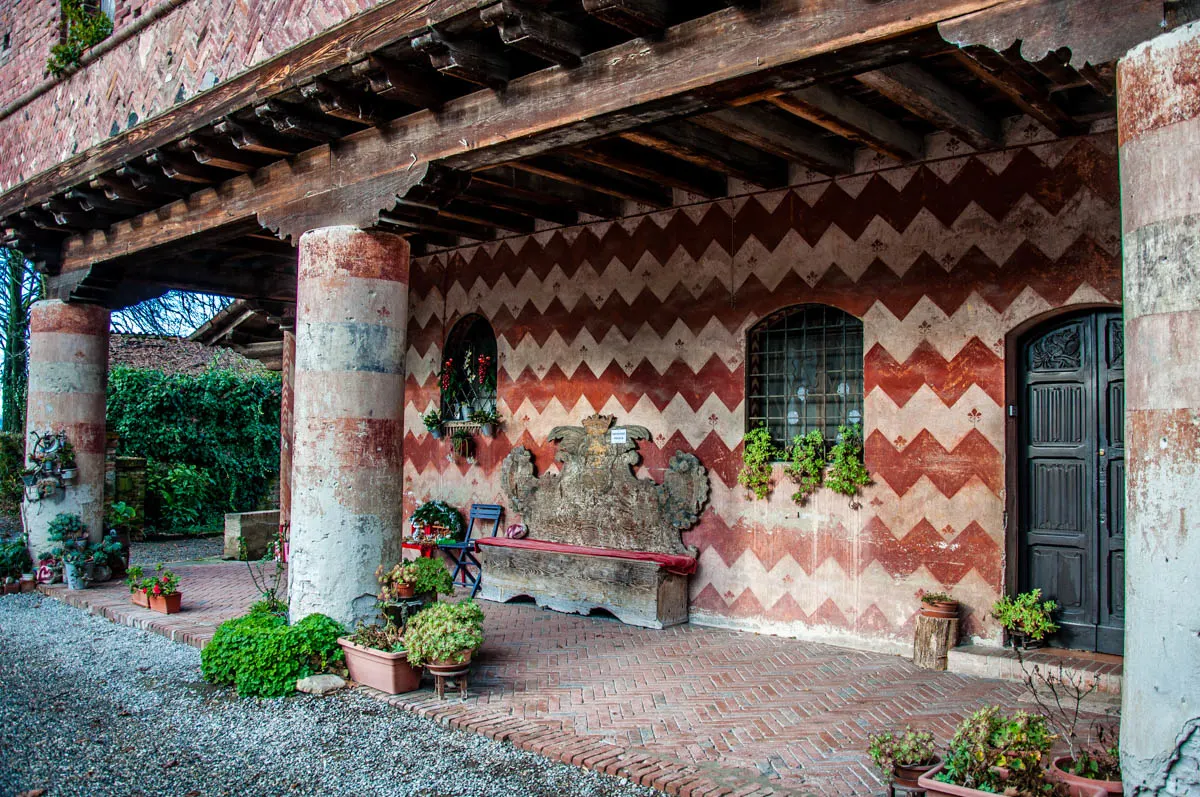
He seems to have been a person of great spirit and a mischievous sense of humour.
Seeing Grazzano Visconti – the masterpiece of his life – illustrated perfectly well that in this life those who are not afraid of potential ridicule and have a get-up-and-do-it attitude end up having the most fun and the most satisfaction of what they have achieved.
What else to see nearby:
You can combine a visit to Grazzano Visconti with the provincial capital of Piacenza (just over 20 mins away). This is one of the most important cities in the region of Emilia-Romagna, Italy. With Etruscan, Gaul, and Roman roots, Piacenza nowadays has many sights, palaces, and churches to entice the curious traveller and a renowned local cuisine centred around pork, polenta, and wine.
Grazzano Visconti is just under 35 mins away from Castell’Arquato and just over 35 mins away from Bobbio – another two entries on this list of the five most beautiful villages in Emilia-Romagna. So, if you are a speedy sightseer, you can theoretically spend a long day splitting your time between the three thus enjoying triple the beauty and the history of this corner of Italy. If you can help it, don’t rush it though as there is much to see in all three of them.
Grazzano Visconti is just over 1 hour away from Parma – another important city in Emilia-Romagna that is worldwide famous for its culinary traditions. Finally, Grazzano Visconti is just under 2 hours away from Emilia-Romagna’s capital – the city of Bologna.
Alternatively, Grazzano Visconti can be a fun day trip from the neighbouring region of Lombardy (45 mins from Cremona, 1 h 5 mins from Pavia, and 1 h 25 mins from Milan).
In Conclusion
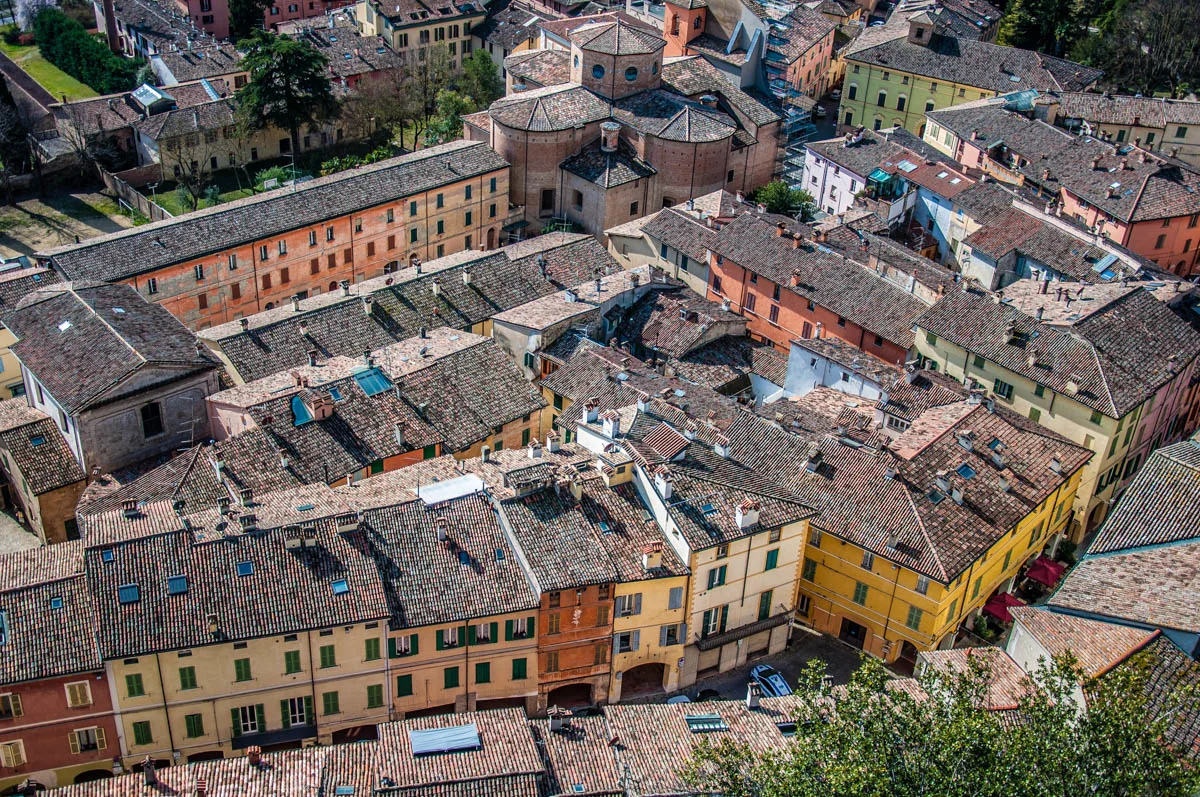
Visiting Italy’s villages is a wonderful way to get to experience this beautiful country in the most authentic way. Local traditions, centuries-old recipes, medieval fortifications, stone churches, precious frescoes are preserved in the small villages that dot the Italian landscape. They are a great destination off the beaten path and a place where you can experience both the history and nature of Italy in the most immediate and genuine way.
In the above blog post, I introduce you to the five most beautiful and interesting villages to visit for yourself in the northern Italian region of Emilia-Romagna. While most people come here for the regional capital Bologna, I invite you to leave Emilia-Romagna’s larger cities behind and spend at least a day getting to know the local villages and their secrets.
The villages covered above are called Bagnacavallo, Bobbio, Brisighella, Castell’Arquato, and Grazzano Visconti. You will find them in the provinces of Ravenna and Piacenza. I have provided details on what to see and experience in each together with helpful information about what else you can do in the adjacent area.
I hope that this blog post will give you the impetus to explore Italy off the beaten track and to visit at least one of Emilia-Romagna’s most beautiful villages.
Enjoy!
More Links to Help You Discover Italy Authentically
- Italian Villages or 6 Reasons to Visit Italy’s Picturesque and Historic Borghi
- 8 Most Beautiful Villages to Visit in the Veneto, Italy
- 5 Most Beautiful Villages to Visit in Friuli Venezia Giulia – The Northeasternmost Corner of Italy
- Bologna, Italy – 10 Stories to Introduce You to the Fat Lady of the Italian Cities
- Ravenna, Italy – 10 Stories to Make You Want to Visit the City of Mosaics Now
- 3 Universities in Italy You Need to Put on Your Travel Wish List Now
- Italian Piazzas – 20 Most Beautiful Squares in the Veneto, Northern Italy
- Best 12 Towns to Visit Around Lago di Garda – Italy’s Largest Lake
- Day Trips from Verona – 16 Destinations to Fall in Love With (With Travel Times and Train Tips)
- Day Trips from Padua, Italy – Over 35 Unmissable Destinations in the Veneto, Lombardy, and Emilia-Romagna
- Day Trips from Vicenza, Italy – Over 90 of the Best Destinations
- 11 of the Best Day Trips from Venice (With Lots of Photos, Travel Times and Italy Train Tips)
- Hidden Gems in Venice – 101 Things to Do in Venice Off the Beaten Track
Thank you for reading! Please, leave me a comment, pin the image below or use the buttons right at the top and at the end of this blog post to share it on social media.
For more useful information like this, please, like my blog’s page on Facebook and subscribe to my strictly no-spam newsletter.
